

9 Killer Speech Openers to Start a Talk or Presentation.

Danny Riley 8 min read
What you’ll learn:
- The importance of a “killer” speech opening.
- 9 powerful speech openers and how to use them.
- Examples from great speakers you can learn from.

Great speech openers hook your audience.
“ Well begun is half done” – Mary Poppins.
A killer speech opener will make the difference between a presentation that makes you soar or your audience snore .
I’ve researched the whole web to find nine killer speech openers to make your audience lean in and listen rather than tune out and daydream.
You’ll see how masters of the craft have used them, and how you can too.
Number seven takes hutzpah to pull off. Ready for the whole list of killer speech openers?
The Shock Opener
One of the best ways to open your speech with a buzz is to startle or shock them.
You can shock an audience in many ways, but they all rest on the major senses of VAKS:
- Kinesthetic (touch)
We don’t want your audience tasting your talk, but it should leave a good taste in their mouths.
Changing Minds suggests asking if the audience is awake after appearing from a flashbang and a cloud of smoke, and this might work for you if you’re a magician or playing some kind of character for your speech like a genie.
Suppose you aren’t going for the magic angle.
In that case, you can shock them on a psychological level instead, as Conor Neill recommends, and tell your audience a surprising fact or statistic that makes them question their thinking or beliefs.
“Did you know that half the water on earth is older than the sun?”
Questions like these will shake an audience awake and turn on their critical thinking nervous-system.
Don’t take my word for it; you can see an incredible demonstration of the shock opener in Mohammed Qahtani’s speech, The Power of Words .
Qahtani opens by taking out a cigarette and placing it into his mouth before trying to light it. The audience is so shocked that they gasp and tell him to stop.
Remember, if your audience is shocked, they are listening.
Your audience doesn’t always have to be jolted to attention with a shock opener, though you can use a more subtle approach to grab their focus.
Ready to speak with confidence ? Explore our training options...
The story opener.
You can set the tone of your speech instantly with a story .
In Hollywood, filmmakers and directors use an ‘establishing shot’ to set the tone and theme of the entire film.
When creating your speech, think of a short story that sums up your talk.
Maybe you tell half the story to begin with, and then the other half at the end.
The important thing is your tale must be relatable . If your audience can’t imagine themselves in the story, they won’t be engaged.
We all experience very similar things in life:
- We all went to school and had a teacher we loved
- We all have parents who loved us or made mistakes in our upbringing
- We all had a first crush.
We are all cut from the same cloth, so it’s good to be reminded that others are going through what we face or think as we do.
Bryan Stevenson does a stellar job of recounting his mischievous grandmother in his TED talk, We need to talk about an injustice .
The best thing is, you can combine a story-opener with any other speech opener in this list.
It’s truly versatile.
One of my favourite speech openers is next, though.
The Intrigue Opener
I love this speech opener.
What better way to hook your audience than to intrigue them with mystery or a juicy secret?
Take a look at Daniel Pink’s TED Talk The puzzle of motivation . After he begins, Pink, looking like a guilty man sent to the gallows tells his audience:
“I need to confess something, at the outset here. A little over 20 years ago, I did something I regret. Something I’m not particularly proud of”.
Wow. How intriguing, right?
You have to admit; you want to know what he’s about to confess.
Choose every sentence, every word, and every mark of punctuation to increase the tantalisation temperature.
Whether it’s a secret or confession, the Intrigue Opener piques just enough curiosity in your audience to keep them from checking Whatsapp.
As humans, we need closure.
We do not like open loops.
That’s why it is both enthralling and aggravating when someone plays on our need to be sure.
Just as we cannot stand an open loop, we are instantly engaged when someone gives us a puzzle to solve.
You’ll notice the best speeches, books, tv shows, and films do not spoon feed you all of the information.
I’ve always liked the way Malcolm Gladwell writes his non-fiction books because they contain puzzles that you solve as a reader.
This puzzle needs to be related to the speech or presentation you’re delivering, of course. It cannot be a random puzzle and will ideally be impossible or extremely difficult to solve at first.
After the speech begins and the puzzle is revealed, you should slowly drop hints on how to solve the mystery.
Up next, speech openers that use a physical object to create curiosity in the audience’s mind.
The Prop Opener
One of the most potent ways you will captivate your audience is to use a powerful prop in your opening address.
What better way to capture an audience’s imagination than to show them a mysterious or beautiful object?
If you’ve never seen the Prop Opener done well, then take a look at one of the greatest speeches of all time:
Dananjaya Hettiarachchi’s, See Something .
Danajaya enters with a simple rose in his breast pocket, takes it out, gazes at it nostalgically, smells it and then begins to speak.
This same prop appears again right at the end of his speech to end his talk with a flourish.
There are many different props you can use.
JJ Abrams used a Mystery Box to absorb the audience’s attention and used the box as a metaphor for his entire career.
If you think the prop opener is just for TED Talks and Toastmasters Final Speeches, remember that most company product launch centre around one or more props.
Steve Jobs revealed his new products in ever-innovative ways.
Still, while the last two speeches I’ve mentioned opened with physical items, most of Jobs’s presentations built intrigue through the sight of the product.
So remember, you can use an object, or tease your audience with the absence of a prop, but make that prop integral to your talk.
You don’t always have to use a prop, of course.
A more minimalist approach to opening your speech uses the best audience reaction a speaker can receive: laughter.
The Funny Opener
Using laughter to win over your audience is the golden ticket to immediate rapport with your audience.
Jack Schafer, PhD at Psychology Today, said that People Will Like You If You Make Them Laugh , which seems obvious, but at least you know we have scientists on the case.
He also mentions that constructing humour requires and projects a high level of intelligence .
Of course, laughter is subjective, but it is also infectious, and if you get enough members of your audience to titter, it will spread across the whole group.
If you want to see just how quickly you can win an audience over with humour, take a look at Ken Robinson’s subtle but delightful ability to raise a chuckle in his speech Do Schools Kill Creativity?
Ken’s ability to speak conversationally to an audience of thousands is genuinely remarkable.
If you break down his humour, it is easy to see how you could include similar content in your presentations.
Whether you can pull it off as well as Ken is another story.
Not everyone feels like they can be a comedian, though; I get that.
Well, that’s alright because there are other ways to open your talk that play on other strong emotions.
You can inspire your audience too.
The Inspirational Opener
One of my favourite ways to help beginner speakers to open their presentation is with a quote.
A quote acts like a story in that it sets the tone and theme of your speech, but it takes much less effort and even less skill.
An effective quote is usually only one line long and supported by the credibility of the original author who uttered those words.
Watch the way Clint Smith opens his TED Talk The Danger of Silence .
Using Martin Luther King’s voice to start his speech gives Clint what psychologists call the transference effect .
Just by citing someone else, especially someone admired and famous, you redirect the emotions an audience have towards that person onto yourself.
One caveat to using quotes, though:
Fact check them . I cringe whenever I see someone incorrectly quoting someone.
Have you ever heard the quote by Albert Einstein:
“Insanity is doing the same thing over and over, and expecting different results”?
A great quote, isn’t it?
But Albert Einstein never said those words .
A quick check on Reuters will help you add more credibility to your inspirational opener.
Finally, try to use a quote few people have ever heard. Inspiring words have been filling the archives of history for millennia, so seek out something that has been left dusty on the shelf rather than the same recycled iterations.
Next, let’s look at a type of bold speech opener that take real hutzpah to land well.
The Perspective Shift Opener
A powerful speech opener that will take confidence is the perspective shift opener.
This opener will lead the audience in one direction before changing direction and setting a new pace for the speech.
Cameron Russel does a fantastic job of controlling the frame in her TED Talk Looks aren’t everything. Believe me; I’m a model.
Russel takes to the stage dressed in a skimpy dress and begins to tell the audience about her career, but then does a rapid wardrobe change on stage in front of the entire audience.
This change of dress sets a new tone, feel, and direction for the speech.
If you can change the audience’s perspective or frame of reality, you are in the driving seat.
One of the best things you can hope for as a speaker is moving hearts and changing minds.
If you aren’t a confident speaker, start small.
Vanessa Van Edwards suggests never mentioning how nervous you are.
It’s distracting and makes the audience pick up on all the subtle nervous energy and cues you give off. Control the frame instead and act cool and confident: they will buy into it.
Another great way to hold frame control over an audience is by using the power of silence .
The Silence Opener
Silence is a valuable commodity in today’s noisy and distracting digital world.
Creating silence at the beginning of your talk can profoundly affect your audience and their focus.
Did you ever have a teacher at school who used silence effectively?
When my English classmates were noisy, our teacher Mr Rylance would hold up his hand in silence.
Slowly we would settle down and focus on his raised hand.
A few would giggle, but that would peter out until we all wrapt in a hypnotic stillness.
If you want to see an example of how to use silence, then look at Neal Glitterman’s speech The Power of Silence .
You can see how much gravity silence can have , especially as a speech opener.
The final killer opener I want to introduce you to is the big promise opener.
The Big Promise Opener
I believe that all speeches and presentations should contain a big promise as it tells your audience why they should keep on listening.
Ideally, your big promise will be your speech title or phrase that pays which is a recurring foundational phrase you will use throughout your presentation.
A big promise is your way of making a deal with the audience : you listen to me, and you’ll get something in return.
Creating a big promise at the beginning of your speech is like adding a teaser trailer to the beginning of a TV show. It suggests a reason you should stick around.
When Arthur Benjamin introduces his talk Faster than a calculator by announcing:
“I am a human calculator!”
You know that proof is on the way.
Remember the essential rule of the Big Promise Opener: make it big and keep your promise.
WOW your audience with these killer speech openers.
I hope you feel that I kept my promise of sharing nine killer speech openers to start a presentation.
Did you notice any other speech openers at the beginning of this article?
Don’t forget; these openers can be mixed and matched.
You can include a number of these speech openers in the same presentation to create more impact.
Let me know which of these killer openers was your favourite, and let me know if you have any more you’d like to share.
– Danny Riley
Join 350+ leaders getting my weekly tips on confidence and charisma... 👇
Navigation:.
Home About Success Stories Contact Privacy Policy
Work with Ed:
1-to-1 Coaching 1-Day Masterclass Team Training
Follow/Connect:
Get started:, copyright © 2023 project charisma ltd. all rights reserved..

- Group Training
- Corporate Coaching
- 1 ON 1 Coaching
- Online Course
- Customer Care Policy
HOW TO WRITE A KILLER SPEECH IN 6 SIMPLE STEPS
Writing a speech can be a very daunting task. You feel overwhelmed with ideas, you don’t know where to start, how to end, what to talk about it, how to develop your ideas and the list goes on. The good news is writing a killer speech is really easy when you keep in mind the following six simple steps:
1. Be very clear about the topic of the speech 2. Answer the main question with two to five key points… Ideally three 3. Elaborate on these answers 4. Nail the introduction 5. Have a strong conclusion 6. Pay special attention to transitions
1. BE VERY CLEAR ABOUT THE TOPIC OF THE SPEECH
This is the number one and most important element of any speech. It is the foundation that the entire speech rests upon. If you are not clear about your topic then writing the speech will be extremely difficult and the end result will be a speech which is difficult to understand.
So how do you make sure that the topic is very clear?
The best way to make sure that your topic is very clear is to ensure it answers one of the following questions:
WHAT? WHY? or HOW?
For example, suppose you want to write a speech about “Travel”. Travel is a very broad topic. Writing a speech about it without being very clear about what aspect of travel you want to talk about will be like going down a rabbit hole.
Here are some examples that demonstrate how you can use the method of WHAT, WHY, HOW to get really clear on your speech topic.
- What are the best countries to visit this year?
- What are the best methods of travel?
- What are the most important things to keep in mind when travelling with kids?
- Why is travelling the best form of education?
- Why is it important to travel to places you have never been to before?
- Why travel on a train, rather than on a plane?
- How travelling can change your life?
- How to travel on a budget?
- How to travel without leaving your home?
It is important to note that the title and the topic of the speech need not be the same. For example, if you choose the topic: “why travel on a train, rather than on a plane”, you could for example have the title: “Trains not Planes”. Or, “Ditch the Plane, Jump on the Train”, etc.
2. ANSWER THE MAIN QUESTION WITH TWO TO FIVE KEY POINTS… IDEALLY THREE
Once you have a very clear question in mind, it is time to find answers to it. Preferably you want to answer the question in using two to five key points. Anything less will come across as too little, and anything more will come across as too much.
Whilst anything between two and five key points is recommended, the ideal number is three. Three is the magic number in public speaking, it is just right. It is not too little and not too much..
For example, let’s say you chose the speech topic: “why travel on a train, rather than on a plane”. You can for example have the following three answers:
- Trains are usually cheaper
- Trains make you appreciate the distances
- In trains you experience a gradual shift of culture
The same principle applies to any other speech topic questions you choose.
3. ELABORATE ON THESE ANSWERS
You now have a main speech question and two to five key answers. Next is to elaborate on these answers. You can elaborate by explaining what you mean by each point, by using examples, stories, statistics and other relevant supporting information.
For example, building on the three answers from the previous point.
1. Trains are usually cheaper
A while ago I had a deep desire to explore the world. There was one problem: I was on a very tight budget! A quick calculation made me realise that airplane tickets will cost me more than half of my travel budget. I started thinking of ways to save money: cheaper hotels, camping, cooking at home. I then realised that I could save a lot of money by travelling by train rather than always going on a plane.
2. Trains make you appreciate distances
A great thing about travel is that it widens your horizons and helps you see the world in a whole new light. One of the biggest things I realised when I travelled in trains was how big the world is! In an airplane we travel halfway across the world in around 10 hours. The same journey will take days if not weeks in a train. This experience alone made me see the world in a totally different light.
3. In trains you experience a gradual shift of culture
When I travelled in trains I witnessed how cultures gradually change across countries, towns and villages. It was an incredible experience that I would not have had had I travelled in planes.
In the examples above, I provided just a few lines of elaboration for each point for demonstration purposes. However, in practice you can elaborate further by adding more stories, examples and explanations.
4. NAIL THE INTRODUCTION
Although the introduction is the first element of the speech, it is not necessarily the first one to be written. In fact it is recommended that you write the introduction after you have decided on the topic and written the body of the speech. The reason for this is the purpose of the introduction is to let the audience know what the speech is about. Before deciding on the topic and writing the speech you usually have a hazy idea of what the entire speech is about and therefore the introduction tends to not be very clear and focused when written first.
A crucial part of the introduction is the first sentence. The first sentence is the most important sentence in the entire speech. It sets the energy, pace and feel of the rest of the speech.
There are four recommended ways to start a killer speech.
- Did you know that it is possible to travel from Portugal to Vietnam solely by train?!
- If time was unlimited, I would choose to travel by train instead of plane every single time!
- I love trains!
2. A question : A powerful way to gain insight about the audience can be by starting with a question. There are a couple of things to keep in mind when doing this:
- Make sure it is a closed question( Yes or No question). You don’t want to ask a question that has an elaborate answer. For example, an effective question would be: Who here has ever used trains to travel between continents? A example of a ineffective question: what is the longest train route in the world? A closed question ( Yes or No question) is personal, easy to answer, and will engage the audience as everyone can answer it.. An open question is difficult to answer and will engage only a certain members of the audience.
- Indicate to the audience that you want an answer. Either by putting your hand up to let them know that you would like a response or by using a phrase such as: “by show of hands”
- A quote : A powerful way to start a speech is by using a quote. You can find a quote by googling quotes online relevant to your topic. For example, you can start the speech by saying: Anna Funder once said: “I like trains. I like their rhythm, and I like the freedom of being suspended between two places, all anxieties of purpose taken care of: for this moment I know where I am going.”
- A story . This is a very engaging way to start a killer speech. A personal favourite of mine. It is preferable to share a personal a story but you can also tell a story you have heard.
After the first sentence, whether it is a statement, question, quote or story, you can let the audience know what the point of the speech is. For example:
Did you know that it is possible to travel from Portugal to Vietnam solely by train? It is a 17,000 km trip that takes an estimated 275 hours. The same trip takes around 16 hours by plane, yet I will share with you why it is a great idea to do this journey travelling by train..
5. HAVE A STRONG CONCLUSION
The conclusion has a precise role in speeches. In the conclusion you want to remind the audience of what you have covered in the body of the speech and/or have a call to action.
For example, you can conclude the speech as follows:
- If you have the luxury of time, I highly recommend to travel by train. It is cheaper, it makes you appreciate distances and it exposes you to the gradual shift in culture.
In the previous example the conclusion was both a summary and a call to action. You reminded the audience of the three key points you mentioned in the speech which in turn were calls to action themselves.
There are few things to consider when writing the conclusion:
- Make sure you end on a strong note. You don’t want to end your speech they saying something like: Yeah and that’s it , or, I think I have covered everything , or, shall I finish here or do you want me to tell you about an awesome story I once happened to me on the train?
- Make sure you do not add a new point. Adding a new point that was not covered in the body of the speech usually leads to confusion and incoherence of ideas. For example the following conclusion is not ideal: If you have the luxury of time, I highly recommend travelling by trains. I did not mention also how when you take the train you don’t need to be at the station hours before departure . In this example a new point has been introduced that was not mentioned in the speech.
- Make sure you do not sabotage the main topic by contradicting yourself. Here is an example of contradicting oneself: While trains are sometimes better than planes. If you do not have the luxury of time just use the plane instead. In this example a point that was not inline with the purpose of the speech has been added. This sabotages the main purpose of the speech which is encouraging people to use trains
6. PAY SPECIAL ATTENTION TO TRANSITIONS
Transitions are the sentences that connect one element of the speech to another. Transitions are needed to make any speech flow smoothly. Think of them as the lubricants of the speech. Without transitions the speech will be clunky, disjointed and robotic. Always remember to pay special attention to transitions because it is very easy to forget about them, not place enough importance on them or miss them out altogether. In fact, when clients ask me: “Should I memorise my speech?” My answer is: You do not have to memorise the entire speech word for word. However, I always recommend you memorise the introduction, the conclusion, the structure of the body (the 2 to 5 key points) and the transitions between each of these sections.
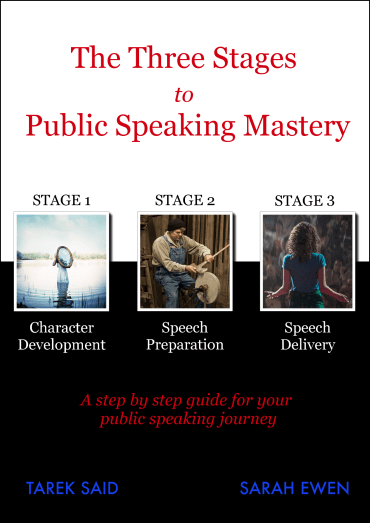
Start getting better at public speaking today!
We distilled the art of public speaking into three concise and easy to read chapters: Character Development, Speech Preparation and Speech Delivery.
If you want to overcome your fear of public speaking, learn how to write engaging speeches and read about the speech delivery concepts then this book is for you. Start getting better at public speaking by clicking the button below.
Share This Story On:
To book a service or for any questions please get in touch by completing the form below.
CONTACT TAREK
Contact sarah.
Please get in touch by completing the form below

6 Examples of Killer Speech Openings That You Can Use
Think about a speech you saw or heard that stuck with you. What is it about that speech that makes you remember it long after you’ve heard it? The speaker was probably dynamic and engaging or the topic was compelling and of particular interest to you. The speech probably had a killer opening as well.
The introduction to a speech is one of its most crucial aspects. It’s where you grab your audience’s attention and set the tone for the rest of the speech. If your speech opening isn’t memorable, the rest of your speech probably won’t be either.
To help you understand the impact a good opening can have, here’s a list of six killer speech intros. The fact that these speeches are so memorable shows why public speaking is important and why your introduction should be strong.
Julian Treasure: Start with a question
“The human voice: It’s the instrument we all play. It’s the most powerful sound in the world, probably. It’s the only one that can start a war or say ‘I love you.’ And yet many people have the experience that when they speak, people don’t listen to them. And why is that? How can we speak powerfully to make change in the world?”
Julian Treasure’s speech “How to speak so that people want to listen” showcases a tried and true speech opening technique: asking a question. You shouldn’t ask just any question, though. It should be a compelling, thought-provoking question that doesn’t have a straightforward answer.
Asking the audience what they had for lunch that day isn’t compelling, unless you have an interesting reason for asking it that you follow up with. Treasure’s compelling question doesn’t require an immediate answer but instead asks you to think.
Ric Elias: Incredible story
“Imagine a big explosion as you climb through 3,000 ft. Imagine a plane full of smoke. Imagine an engine going clack, clack, clack, clack, clack, clack, clack. It sounds scary. Well, I had a unique seat that day. I was sitting in 1D.”
One way to grab the attention of your audience right away is to tell an exciting or unbelievable story. Ric Elias’s speech about surviving a plane crash goes straight into the action, asking the listener to imagine unbelievable situation he was in. With an opening like that, who wouldn’t want to keep listening to find out what happens next?
To make your intro story more effective, don’t finish it right away. Come back to it later in the speech so that your audience is held in anticipation.
Dan Pink: Make a “confession”
“I need to make a confession at the outset here. A little over 20 years ago, I did something that I regret, something that I’m not particularly proud of.”
Dan Pink’s speech grabs your attention right away because he makes a confession. He’s letting you in on a secret about himself or something he did and you want to listen because you want to hear it.
Letting your audience know a secret or confessing information about yourself makes them feel exclusive, like they have access to something that others don’t. Exclusivity always piques interest.

Jane McGonigal: Provocative statement
“I’m a gamer, so I like to have goals. I like special missions and secret objectives. So here’s my special mission for this talk: I’m going to try to increase the life span of every single person in this room by seven and a half minutes. Literally, you will live seven and a half minutes longer than you would have otherwise, just because you watched this talk.”
Starting a speech with a provocative statement is similar to starting with a question. You make the audience think. You surprise them or say something unexpected and they keep listening to hear an explanation.
Jane McGonigal uses this tactic in her speech , claiming she will expand the life span of every audience member by seven and half minutes. It’s intriguing, provocative, and makes you wonder instantly how she’s going to do it.
Pamela Meyer: Set up a problem (then solve it)
“Okay, now I don’t want to alarm anybody in this room, but it’s just come to my attention that the person to your right is a liar. Also, the person to your left is a liar. Also, the person sitting in your very seats is a liar. We’re all liars.”
People love hearing about a big problem and then knowing the solution — it’s a common framework from literature that you can borrow for your speech. By telling her entire audience that they are liars, Pamela Meyer sets up a problem that seems difficult to solve: how to know who is a liar. She unravels the solution in the rest of her speech , explaining how to become a liespotter.
Sir Ken Robinson: Humor
“Good morning. How are you?” (Audience replies “Good”) “It’s been great, hasn’t it? I’ve been blown away by the whole thing. In fact, I’m leaving.”
Humor can be an impactful way to start a speech, but it’s also risky. Your joke might fall flat and leave everyone feeling uncomfortable. If you tell the right joke, however, it can go over well.
Sir Ken Robinson’s speech , “Do schools kill creativity?” is one of the most watched TED Talks of all time and for good reason. His speech is engaging and dynamic, centering on a topic that almost everyone can easily relate to. What could’ve been a boring start — “Good morning. How are you?” — becomes a funny and memorable speech opening thanks to Robinson’s timing and deadpan delivery.
Make your speech opening memorable
If you want to deliver an engaging address that your audience members will speak about years later, be sure to craft an unforgettable opening. By using any of the above techniques, you’re likely to have a more solid start to your speech. Who knows? Maybe your speech opening will be so good it’ll end up on a list just like this one.
You May Also Like
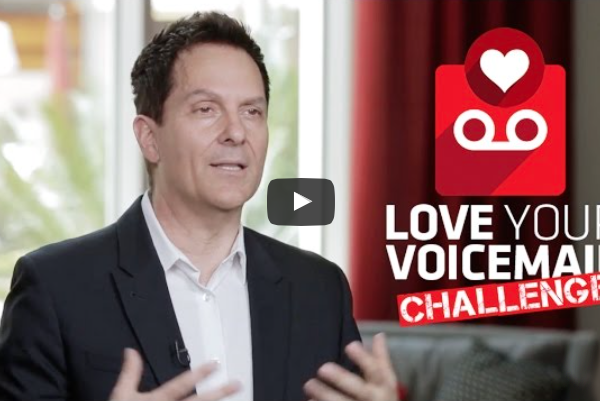
The Secret to Good Storytelling
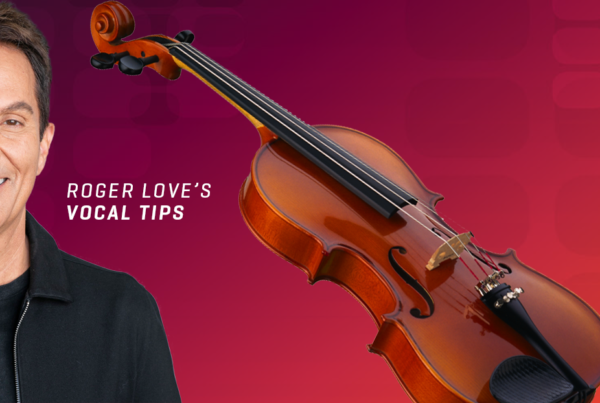
- SUGGESTED TOPICS
- The Magazine
- Newsletters
- Managing Yourself
- Managing Teams
- Work-life Balance
- The Big Idea
- Data & Visuals
- Reading Lists
- Case Selections
- HBR Learning
- Topic Feeds
- Account Settings
- Email Preferences
How to Give a Killer Presentation
- Chris Anderson

For more than 30 years, the TED conference series has presented enlightening talks that people enjoy watching. In this article, Anderson, TED’s curator, shares five keys to great presentations:
- Frame your story (figure out where to start and where to end).
- Plan your delivery (decide whether to memorize your speech word for word or develop bullet points and then rehearse it—over and over).
- Work on stage presence (but remember that your story matters more than how you stand or whether you’re visibly nervous).
- Plan the multimedia (whatever you do, don’t read from PowerPoint slides).
- Put it together (play to your strengths and be authentic).
According to Anderson, presentations rise or fall on the quality of the idea, the narrative, and the passion of the speaker. It’s about substance—not style. In fact, it’s fairly easy to “coach out” the problems in a talk, but there’s no way to “coach in” the basic story—the presenter has to have the raw material. So if your thinking is not there yet, he advises, decline that invitation to speak. Instead, keep working until you have an idea that’s worth sharing.
Lessons from TED
A little more than a year ago, on a trip to Nairobi, Kenya, some colleagues and I met a 12-year-old Masai boy named Richard Turere, who told us a fascinating story. His family raises livestock on the edge of a vast national park, and one of the biggest challenges is protecting the animals from lions—especially at night. Richard had noticed that placing lamps in a field didn’t deter lion attacks, but when he walked the field with a torch, the lions stayed away. From a young age, he’d been interested in electronics, teaching himself by, for example, taking apart his parents’ radio. He used that experience to devise a system of lights that would turn on and off in sequence—using solar panels, a car battery, and a motorcycle indicator box—and thereby create a sense of movement that he hoped would scare off the lions. He installed the lights, and the lions stopped attacking. Soon villages elsewhere in Kenya began installing Richard’s “lion lights.”
- CA Chris Anderson is the curator of TED.
Partner Center
- 07968 946519
- – Life
- – Career
- – Business
- Reading Room
- Courses & Mentoring
- All Services
How to Write a Killer Speech (for Zoom)
13 january 2021.
It’s not every day you get invited to take part in a radio discussion about public speaking, with the lead singer from Urban Cookie Collective.
But that’s what happened to me on Monday.
The topic of the show, broadcast on BBC Essex , was how speaking to groups of people has changed, since we’ve all been forced online. How do you write a father-of-the-bride speech, or keep people engaged on a work presentation, when each member of your audience is effectively listening in from another room?
I was drafted in to discuss the speechwriting element, with the how-to-do-the-actual-talking bits covered by Danielle Barnett (she of Urban Cookie Collective, and now a transformation coach), and Nicky Browne of The Mighty Oak, an organisation that teaches public speaking in schools.
As is my wont, I assiduously prepared for my part of the discussion, writing copious notes about how to write words for an online audience, as well as rooting out a selection of illustrative examples.
But since the host (inconsiderately, in my opinion) let his other guests talk as well, I didn’t get to share everything I prepared.
So, I’m sharing it here, instead.
A Zoom talk means speaking directly into people’s homes…
…which, in turn, means that everything you say will take on a personal hue.
When I worked in HR, colleagues would get upset about their managers suddenly sending them terse, overly critical emails when they chose to work from home.
In reality, the tone of these emails hadn’t changed. What had was the environment in which they were being read. A slightly brusque email from the boss might be OK in the professional context of the office, but at home it’s a personal affront.
What this means for your speech, is that as far as possible, you should try to word it as though you’re talking to one person, rather than a group.
I would also advise not memorising your speech, in the way you might if you were speaking in front of a large group. Use headline notes instead, and speak around them so you sound as natural as possible. Ultra-formality is ultra-off-putting online.
Use humour with caution
Be careful about adding jokes, as you may not be able to hear whether or not people are laughing… which can throw you – and your audience – off.
(I watched an online stand-up comedy gig during Lockdown 1.0, which the comedian clearly found challenging because he wasn’t getting any audience reaction to his material. As a viewer, I also found it unexpectedly uncomfortable in places. Laughing along with others at a joke some might find offensive is all part of the fun when you’re at a rowdy comedy club; at home on your own it feels deranged.)
The lack of instant feedback means you’ll need to be extra-confident about what you’re saying, so that old adage about understanding your message before you write your speech takes on even more importance.
Boiling down the essence of your speech to one simple sentence will help… and if you can’t do that, why are you speaking at all?
Your audience is going to get distracted, so keep it short and memorable
Instead of playing to a captive audience in one room, you’re now dealing with a diverse array of at-home distractions…
…from interruptive children and barking dogs, to doorbells ringing unexpectedly and loud TV noise from the room next door.
That’s why you have to make your speech as short, snappy, and as memorable as you can.
To do this, use clear, simple language that creates “word pictures” , as Winston Churchill once said ( “we shall fight them on the beaches” and ‘iron curtain’ are his own excellent examples), and if you want people to take action on anything you’ve said, summarise it at the end.
Think of the government’s ‘Stay home. Protect the NHS. Save Lives’ slogan. It tells us what we’ve got to do, even if we can’t – or don’t want to – listen to the daily briefings.
“When the content’s right, the confidence will follow” (Philip Collins, former speechwriter to Tony Blair)
Wherever you’re performing your speech, working on your words to the point where you can’t wait to say them will help you sound positive and confident, as well as making it more likely that you’ll finish on a high.
Over and out.
Recent Posts
- An interregnum (of sorts)
- My writing mentoring (probably) won’t make you millions
- Slave to the (algo)rithm?
- Do you have to be deep and introverted to write well?
- Does the ‘perfect’ writing schedule exist?

20 Great Quotes To Help You Deliver A Killer Speech
Want to make your next speech more powerful ? Use superb quotations and use them well. In this article, I will share 20 of my favorite quotations for beginning and professional speakers. And I will tell you when and how to use them.
But before we get into these specific sayings, here are a few introductory suggestions for using quotations when you are a keynote speaker , giving an inspirational message, annual report, sales presentation, after-dinner talk, Sunday sermon, teaching lesson, or any speech you are preparing.
- Use no more than 3 to 5 quotations in your speech. Remember that a quotation is like seasoning on a fine meal. Don’t overuse quotations in your talk. That’s like dumping an entire saltshaker worth of salt on top of your meal. Think of quotes as delicious flavor additives, not the main dish.
- Avoid using quotes that are already well known to your audience. The real (secret) power of a great quotation is its ability to surprise your listeners.
- Take the time to find the ideal quotes for your talk. Go deeper than a google search. Read inspiring books, check out relevant articles, visit your local bookstore or library. Keep a journal and collect the sayings, proverbs, quotations, and bits of wisdom that move your heart and mind.
- Whenever possible, cite the source of your quotation. Give credit where credit is due. And be sure your source is accurate. You will lose credibility if you quote George Washington as an expert on social media! If you cannot track down the original source of your quote, you can simply say, “It has been said…”
- Make sure your quotations support your main message . Sometimes it’s tempting to sneak a great quip or quote into your talk because you love it. First decide if it’s apt for what you want to communicate.
Here Are 20 of the Best Quotations for Your Next Speech Use One of These Great Quotes When You Want to…
Create laughter.
Quoting a comedian, famous wit, ancient proverb, or even a child’s wisdom can generate an instant laugh during your presentation. And trust me, your audience wants to laugh! Here’s the key: Pause before and after you share the funny quotation or short joke. A humorous quotation will surprise, shock, exaggerate, and often convey a tough truth in a way that delights.
“If you’re looking for a helping hand, there’s one at the end of your arm.” ~Yiddish Proverb
Make them THINK
A powerful quotation will give your audience food for thought. First of course, you must determine what you want your audience to understand, believe, and embrace. Then, choose a quotation that packs a punch.
“He not busy being born, is busy dying.” ~Bob Dylan
Grab their ATTENTION
Usually the shorter the quotation, the more powerful the punch. Long quotes, like long speeches, will leave your audiences yawning. To open your speech, you may want to grab your listener’s attention with a short quotation or aphorism. If you are giving a talk about dream casting or goal-setting for example, here’s a fine quotation:
“If you know what you want, you can have it.” ~RH Jarrett
Prove your POINT
You don’t have to agree with every source you quote. Sometimes who you quote, is as important as what you quote. Here’s an example. Though I obviously detest this famous leader, this quotation makes a powerful point. When I am stressing the power of passion, I sometimes share this one. Note: After I give the source—which always shocks the audience—I remind them that he was evil and that we must use the power of passion for good.
“Only a storm of hot passion can turn the destinies of people. And he alone can arouse passion who bears it within himself.” ~Adolf Hitler
Illustrate an IDEA
A good quotation is like a good story. It’s a window in your house. Use it to let the light in. Help your audience see what you are saying. A good metaphor is one of the most helpful tools in a speaker’s toolbox. To get your idea across, use a strong word picture. Imagine giving a talk to a group of schoolteachers. Your goal is to affirm them for the great work they are doing. You want to remind them that what they do—educating children—matters forever.
“A school is a building with four walls, with tomorrow inside.” ~Lon Watters
INSPIRE your audience
The best speeches lift hearts! If your goal is to motivate your audience, insert a quotation designed to inspire the dreams of your audience members. Connect with their emotions. Choose a statement that is filled with hope and encouragement. Here’s one of my favorites, because it strikes such an emotional chord:
“If your heart is in your dream, no request is too extreme.” ~Jiminy Cricket, Pinocchio
Issue a WARNING
You can use a quotation to sound an alarm. You may want to shake your hearers into stopping/starting a behavior. The key here is choosing a quotation that lights a fire under your people. What mindset do you want them to change? What do you want them to do?
“Unassertive salespeople have skinny kids!” ~Zig Ziglar
Make people CARE
Many speakers make the mistake of thinking that their talk is primarily about content. While content is important, the best speakers transfer their conviction to an audience. Your group doesn’t want more information. They are looking for takeaways and transformation.
“I’ve learned that people will forget what you said, people will forget what you did, but people will never forget how you made them feel.” ~Maya Angelou
Capture an INSIGHT
Many times the quotes that will rock your speech are what I call “zingers.” What is a “zinger”? It’s a pithy statement that expresses a flash of insight. Zap your audience with a truth in capsule form. People love to read the fortune inside their fortune cookie—and often the words apply to their lives. When I am giving a speech that talks about how we learn, I love to share this one:
“I respect wisdom but I obey pain.” ~12 Step Recovery Saying
EDUCATE your attendees
Don’t make the mistake many speakers make. Never confuse a statistic with a quotation. Remember: facts tell, stories sell. Search out stories and quotations for your talk that provide “teaching moments.” Tip: Do an Amazon search for aphorism. You’ll discover some great gems and nuggets for your next speech. An aphorism, like a proverb, teaches a memorable lesson-in-a-few-words.
“Don’t expect your ship to come in—unless you’ve sent one out.” ~Belgian Proverb

STRENGTHEN your case
Know exactly what you want to say to an audience. Then you will be in a position to find the perfect quote(s) for your next keynote speech, workshop or seminar. If you are giving a talk on leadership, select a quotation from an inspiring leader. Are you motivating athletes? Choose a motivational saying from an accomplished football, basketball, or soccer player. Most importantly, know your audience. This will help you know which quotation will best support your speech.
“We don’t see things as they are, we see things as we are.” ~Anais Nin
Make your speech MATTER
A good question to ask yourself is: “Who cares about what I am saying?” By the way, this is the very question your audience is asking when you start your speech. How does this matter to me ? Reverse engineer your speech. Think about the big takeaway you want your group to get from your presentation. Then craft your message—and the quotes that will make it pop—based on the actions you want your audience to take.
“The meaning of communication is the response you get.” ~NLP maxim
Use the power of REPETITION
One of the great speeches in U.S. history is Martin Luther King’s “I Have a Dream” speech. And one of the factors that makes it so powerful? MLK’s repeated use of his awesome title: “I Have a Dream.” Consider repeating a strong quotation again and again during your talk. This can help you re-state your core message. You can also hammer home a big point with a quotation that repeats certain words to great effect. Notice how Winston Churchill did this often. (“Never, never, never give in…”), He and MLK are two of the greatest orators of the 20th century. Both leaders repeated words to maximize the impact of their language.
“We are all worms. But I do believe that I am a glow-worm.” ~Winston Churchill
Enhance a CELEBRATION
Maybe you will give your speech at a wedding, an anniversary party, or an awards program. You can pump up the proceedings with a special quote. Identify a sparkling statement that will raise spirits…and maybe wine glasses. Here’s the key to doing this well: Keep the focus on who/what is being celebrated. Your quotation should amplify the purpose of the event. Honor the bride, toast the award-winner, congratulate the champion. Get clear on the reason for festivities. Your quotation should put a spotlight on what your guests are celebrating together.
“Life is short, wear your party pants.” ~Loretta LaRoche
Want to make sport of a competitor? Handle a heckler? Or lampoon an idea you don’t like? A good quote can work wonders. Just be careful about coming across as mean-spirited. Humor helps.
“Lord, help me make my enemies look ridiculous.” ~Voltaire (French Philosopher)
Increase your AUTHORITY
Don’t get the wrong idea here. Quotations are not the source of your authority, you are. But a compelling quote can boost your credibility as a speaker. Select a quote that comes from a recognized name or organization that will resonate with your audience. Quote an expert. Better yet, become one.
“I am the greatest, I said that even before I knew I was.” ~Muhammed Ali
Speak with CONFIDENCE
Want to know a speaking secret? Your listeners aren’t paying that much attention to what you say. But they are tuned in to how you say it. They are listening for your confidence. What do you do if you don’t feel confident? Act like you are. And to take it to the next level—instill confidence in your audience too. Model it.
“Feel the fear and do it anyway.” ~Susan Jeffers
Bring CLARITY
One of the gifts you can bring people via your message is clarity. Help your audience see the path, cut through the clutter, and take decisive action. Make a statement, or share a quotation, that simplifies things for people. Sometimes this can be phrased as a question like, “What would you do if you knew you could not fail?” Other times you will want to give them the answer straight up. A great quote can help you do just that. You want to communicate with great clarity. And show your audience the way forward.
“If you don’t have a plan for your life, somebody else does.” ~Michael Hyatt
Issue a call to ACTION!
You can wrap-up your speech with a mighty quotation to finish strong. Make sure that your final phrase captures the heart of your main message. Don’t end on something cliché like, “Thanks for listening” or “My name is Blah Blah.” Your end quote, if you use one, should empower your audience and echo the main thrust of your talk. And get this: You want to invite your audience to take action.
“The way to get started is to quit talking and start doing.” ~Walt Disney
Create your own CATCH PHRASE
Few people remember speeches, but many people remember speakers. Can you create an original quotation that fits your personal brand? Tap into what makes you unique. What makes your message special? The final words of your speech can remind people about who you are and what you had to say. What is your signature “sign off” sentence? It might be a parting piece of advice. It could also be a statement you design to capture the way you want the group to remember the experience you created for them.
“The tribe has spoken.” ~Jeff Probst, “Survivor”
By finding and utilizing quotations that appeal to you, you will heighten the impact of your speech. Plug one or two of the above quotations into your next speech or special presentation. Better yet, discover the pitch-perfect quotes for your talk. Weave them into your speech and speak with gusto. You’ll be glad you did. And your audience will be pleased too. You can quote me on that.
Adam Christing is a professional keynote speaker, master of ceremonies , and author . He has written four humor and personal transformation books including: Comedy Comes Clean 1 & 2: A Hilarious Collection of Wholesome Jokes, Quotes, and One-liners, Your Life is a Joke: 12 Ways to Go from Ha Ha to AHA! and Bob Dylan Can Change Your Life: 61 Ways to Invent a Legendary You. Adam has been studying and collecting quotations for more than 25 years.
Recent Blog Posts:
- Adam Christing, America’s Most Popular Corporate Emcee And Clean Comedian, Appears On The WOW Factor Podcast
- 7 Ways To Make Your End-Of-Year Staff Meeting Memorable And Meaningful
- The Importance Of Force Majeure Clauses When Corporate Hosting
- 5 Stage Presence Tips From A Master of Ceremonies
- Master of Ceremonies Helps 10 Non-Profit Groups Raise Over $77 Million at 10 Fundraising Events in the Fall of 2023
- The Difference Between Hosting B2B and B2C Events
- 5 Games To Enhance Your Next Annual Company Dinner
- 5 Ways To Make Your Workplace Festivities Inclusive During The Holidays
- 5 Holiday Fundraising Ideas From A Corporate Emcee
- What Is B2B Event Planning? Your Complete Guide
Recommended For You
3 best opening lines to start your emcee gig with, 4 body language techniques that will improve your public speaking, the 6 different types of public speaking.
Comments are closed.
- Get Started
- Event Emcee
- Entertainment
- How To Be A Great Emcee
Subscribe to Adam's newsletter
Laughing Matters
Powered by Big Red Jelly
Connect with Adam:
© 2024 Adam Christing. All Rights Reserved. Privacy Policy . Terms & Conditions .
- EASY BOOKING FORM
How To Write A Killer Elevator Pitch (Examples Included)
Mike Simpson 0 Comments

By Mike Simpson

You’re on the elevator, riding up from the lobby to the top floor to drop off your resume with Human Resources in response to a job posting for your dream career.
You’re excited, but nervous, because you know your resume is going to be just one of hundreds that the hiring manager is going to look over before even thinking about inviting anyone in for an interview.
If only there were a way to make yourself stand out. If only…
The doors open and a woman in a sharp looking business suit steps in with you. She looks over and sees the top floor button is already lit. She smiles and in that instant a current of nervous energy rips through your body. This isn’t just any generic passenger you’re sharing the ride with…this is the hiring manager you’re hoping to impress!
Your heart starts pounding, your palms are sweaty, you feel light headed…

This is your chance!
You have a 12 floor uninterrupted ride up with her and in those moments, in that tiny elevator, she’s your captive audience.
You open your mouth and turn to her with a look of enthusiasm…and speak.
Let’s hope that elevator pitch (or elevator speech) is ready!
Here’s the deal, after you make your successful elevator pitch (which you will after reading this article!), you need to know that you will get an interview…
But here’s the thing: there are over 100 other difficult interview questions you could be asked in your job interview. Sounds stressful right?
Well don’t worry, because we created a free PDF that outlines the most common questions and gives you word for word sample answers that you can use at your next interview.
Click the link below to get your copy now!
Get Our Job Interview Questions & Answers Cheat Sheet!
FREE BONUS PDF CHEAT SHEET: Get our " Job Interview Questions & Answers PDF Cheat Sheet " that gives you " word-word sample answers to the most common job interview questions you'll face at your next interview .
CLICK HERE TO GET THE JOB INTERVIEW QUESTIONS CHEAT SHEET

What Is An Elevator Pitch?
So what exactly is an elevator pitch?
In a nutshell it’s just what it sounds like: a short, 30-60 second well crafted business pitch telling someone who you are and why they should want to hire you .
It’s called the elevator pitch because it’s meant to represent the amount of time you’d have if you were stuck in an elevator with someone riding from the bottom of the building to the top.
“Well, this stinks. I live in a town of nothing but one floor buildings. How am I supposed to use an elevator pitch? Clearly this article means nothing to someone who doesn’t live in the heart of a big city or surrounded by high rise buildings.”
Elevator speeches are good for so much more than just catching someone in a small enclosed space. You never know who you might run into at a cocktail party, or the movie theater, or grocery store…or any other number of places.
A solid elevator pitch will allow you to distill down to the most pure form exactly who you are and what you offer, and that focus can help to set you apart from all the other candidates who are vying for the same job.
Think of it as a commercial and you’re the product . You’ve got 30 seconds to market yourself and convince whoever is listening to not only NOT change the channel, but to buy what you’re selling…you as the Perfect Candidate!!
“So where do I start? Should I lock myself in the bathroom with a stopwatch and pretend it’s an elevator? Do I need a jingle?”
Hmmm…all we’ll say is do whatever works for you…but let’s all agree to skip the singing…for now. Instead, let’s focus on answering a few basic questions by doing a little pretending.
How To Write An Elevator Pitch
Let’s imagine you’re in sales and you just got into an elevator with the CEO of a huge manufacturing company. The doors shut…it’s just the two of you…and you have 60 seconds to convince him to not only listen to you, but to consider you as a potential employee, not just a fellow passenger on a short ride upstairs. So how do you do that!?

Let’s watch…er, we mean, read:
What do you do? Can you tell someone what you do in such a way that it’s interesting? Can you turn it into a quick little anecdote or story that will capture someone’s attention?
“Let me tell you about the time I took our products all the way to the North Pole. I’m in sales. I started out selling refrigerators to moose in Canada.”
Now that we’ve got your job title, can you tell us what you do when you’re doing what you were hired to do?
“In four short years, I’ve helped lead my team to the number one spot in sales…”
Okay, great…but what’s next?! What’s your objective ? What’s your goal?
“…but I knew we could do better. That’s why I took our refrigerators all the way up to the penguins in the North Pole.”
What makes you the best at what you do? Okay, now’s your chance to shine. Why are you the Perfect Candidate?
“Did you know that broken beaks from trying to eat frozen fish is the number one problem facing penguins today? Their issue isn’t that it’s not cold enough for them to keep their fish fresh, it’s that it’s too cold. I knew that by putting their fish in our double insulated hermetically sealed refrigerators instead of the traditional snow bank, the penguins would be able to keep fish fresh longer without having to freeze them, making it easier for the penguins to eat. As a result, we’ve more than quadrupling our current sales and are not only ranked number one regionally, but nationally as well.”
What’s your hook? You’ve just told a great story, but besides being entertained, why should your audience care?
“Now, just imagine what I can do for your products…”
Wait, who are you? D’oh! Nothing says missed opportunity quite like totally forgetting to tell someone your name.
“My name is Bob Mackrel,”
And most importantly…what do you want?
“…and I’m looking for my next big sales challenge. My I give you my business card?”
Boom. And there you have it: the perfect (if not a little outlandish) elevator pitch. In 30 seconds you’ve told your audience what you do, why what you do is important, hooked them in with what you plan to do next for their company, and who you are.
Easy, cheesy, right?
Penguins and refrigerators aside, this pitch was clearly perfect for the audience because our boy Bob knew the CEO, knew the company, and knew that his skills with sales would be a great match. Bob tailored his pitch.
“Again with the tailoring! That’s all you guys talk about…tailoring!”
That’s because it works! Again, think of our commercial analogy. When you’re watching TV, which ads do you skip over or tune out? The ones that don’t apply to you…right? And the ones you listen to and remember are the ones that DO apply to you.
“Ahh…I see what you’re saying. That does make sense!”
The nice thing about an elevator pitch is that it’s short and sweet and to the point, which means once you get the basics figured out, you should be able to use it on just about anyone in any situation…as long as you make sure to always tailor your hook to your specific audience.
Elevator Pitch Mistakes To Avoid
So now that you know what to do in your elevator pitch, let’s quickly talk about what NOT to do.
Speaking too fast.
Yes, you only have about 60 seconds, but try to avoid cramming 15 minutes of information into one minute.
Using highly technical terms, acronyms or slang.
You want your pitch to be easily understood by any audience and that means try to avoid using words that will confuse the average person. The last thing you want is for whoever is listening to you to feel dumb. Remember, think commercial!
Not being focused.
This isn’t a general conversation and you’re not discussing the weather (unless that’s your job, in which case, never mind). Keep your pitch clear and focused.
Not practicing what you’re going to say.
First, write down your pitch. Read it over. Have your friends and family read it. Does it make sense? Make sure it flows well and that there aren’t any spots that feel rough or awkward. Then practice it. Practice it again. Keep practicing it until it becomes so easy for you to pitch that you can do it at the drop of a hat.
Being robotic.
This is all about a face to face interaction with someone you want to impress. Having an easy, approachable, conversational style to your pitch will get you much further than an overly rehearsed monologue approach.
Not having a business card or other take-away with you.
Okay, you’ve sold them on you…now how are they going to get a hold of you when they decide it’s time to bring you in? Make sure you always have something on you to pass on that will allow people to not only remember you, but contact you later on.
Not saying anything.
It does absolutely nothing for you to have a killer elevator pitch if you never use it. Now it’s your turn! Here are three example elevator pitches to get you started. Remember, these are just examples! Make sure you do the work to craft one specific to you and your audience!
3 Great Examples To Use As Inspiration
Graphic designer/logo branding specialist.
Hi, I’m Pam Tone and I’m a graphic designer. Did you know it takes the average person just two seconds to look at a company logo and decide if they like it? Did you know that a badly designed logo can do irreversible damage to a company brand and that most companies go through at least three to four versions in a single year before settling on their final design, costing both time and money? Having worked for over 10 years as a professional graphic designer specializing in brand identification means I’ve built my reputation on the longevity of my logo designs. I can say that not only are my clients happy with what I’ve done for them, but my designs have gone on to win national and international logo and branding awards. I have worked hand in hand with some of the biggest advertising agencies and companies and out of over 300 contracts, have had only one logo changed, and that was as a result of a merger, not poor design. I’d like to bring that award winning history to your company. Would you be willing to meet with me for 20 minutes to go over my portfolio and see how I can help make sure your logo properly reflects your brand?
TEACHER/EDUCATOR
Mobile app developer.
Hi, I’m Chip Ohm and I’m a developer. Did you know one of the biggest challenges facing companies these days is tracking employee work time? Of course, when you have a building where your employees are required to clock in and out it makes things easier, but what about employees who work from home or are on the road? I’ve come up with an easy way for both employees and employers to log and keep track of hours using just their cell phones and an app I’ve designed. The app allows employees to log in from wherever they are and input their start and stop times at the push of a button. You don’t even need to be in an area with a signal. The program captures all the data and holds it in a file which is then automatically uploaded to the employer’s servers as soon as the user is back in signal range. The system is not only simple, but it’s tamper proof. Not only has this app helped streamline the timecard process for remote employees, but it’s reduced timecard inconsistencies and paycheck errors by 90%, saving both time and money. So, how does your company handle logging in hours for your remote clients?
So there you have it! Now that you’ve read through this article and seen a few examples, it’s time to craft your own elevator pitch. Remember, keep it simple, keep it short, and keep it tailored.
And as always…good luck!
FREE : Job Interview Questions & Answers PDF Cheat Sheet!
Download our " Job Interview Questions & Answers PDF Cheat Sheet " that gives you word-for-word sample answers to the some of the most common interview questions including:
- What Is Your Greatest Weakness?
- What Is Your Greatest Strength?
- Tell Me About Yourself
- Why Should We Hire You?
Click Here To Get The Job Interview Questions & Answers Cheat Sheet

Co-Founder and CEO of TheInterviewGuys.com. Mike is a job interview and career expert and the head writer at TheInterviewGuys.com.
His advice and insights have been shared and featured by publications such as Forbes , Entrepreneur , CNBC and more as well as educational institutions such as the University of Michigan , Penn State , Northeastern and others.
Learn more about The Interview Guys on our About Us page .
About The Author
Mike simpson.

Co-Founder and CEO of TheInterviewGuys.com. Mike is a job interview and career expert and the head writer at TheInterviewGuys.com. His advice and insights have been shared and featured by publications such as Forbes , Entrepreneur , CNBC and more as well as educational institutions such as the University of Michigan , Penn State , Northeastern and others. Learn more about The Interview Guys on our About Us page .
Copyright © 2024 · TheInterviewguys.com · All Rights Reserved
- Our Products
- Case Studies
- Interview Questions
- Jobs Articles
- Members Login

How to Write a Killer Best Man Speech: Ultimate Guide for a Great Speech
- March 18, 2024
- , For Brides
Being chosen as the best man for a wedding is an honor that comes with great responsibility. One of the big tasks you’ll have is giving a memorable best man speech. It’s a chance to celebrate the groom, entertain the guests, and show your support for the happy couple. I’ve yet to be a best man at a wedding, so I haven’t been forced to go through the stress of writing one, but I have seen hundreds of speeches over the years. Some were great, and many were horrible. Writing a great best man speech requires careful planning, personal touches, and confident delivery. Let’s see how you can make your best man speech a standout moment at the wedding and not a total flop.
Understanding the Importance of Your Best Man Speech
Your best man speech is an important part of the wedding reception. While there are some things that are similar to the maid of honor’s speech, I still find them pretty different. The maid of honor tends to be more emotional while the best man tends to be funnier. It shows your relationship with the groom and also a chance for other people to learn more about him. A great toast can really be an emotional moment for the couple and the guests.

How to Start Crafting Your Best Man Speech
Start writing out all of your thought, feelings and memories.
Back when I was an English teacher, I would always make students do a free write. This was basically a time where they just wrote and wrote and wrote. It didn’t really matter as long as they were writing. This is a great thing to do before you really start to write your best man speech. You know the groom, but you might not remember everything at first. Simply writing and writing will get all types of things out.
Using a Template as a Guide
Most guys have never had to write a best man speech before, and most have never even been to a wedding. It’s normal to have no idea where to start for your wedding speech. That’s why it’s a good idea to use a template. Templates can serve as a helpful starting point for your best man speech. While you do want to throw in your personality and experiences, having a template can at least give you an idea on what all to include.
Unique Opening and Closing Lines for Your Best Man Speech
The opening and closing lines of your best man speech leave a lasting impression. Find a compelling opening that grabs the audience’s attention and sets the tone for your speech. Then, end your speech with a memorable closing that ties back to the theme of your speech and expresses your well-wishes for the couple. This is going to be different for each wedding and each relationship, but maybe use a quote or an inside joke.
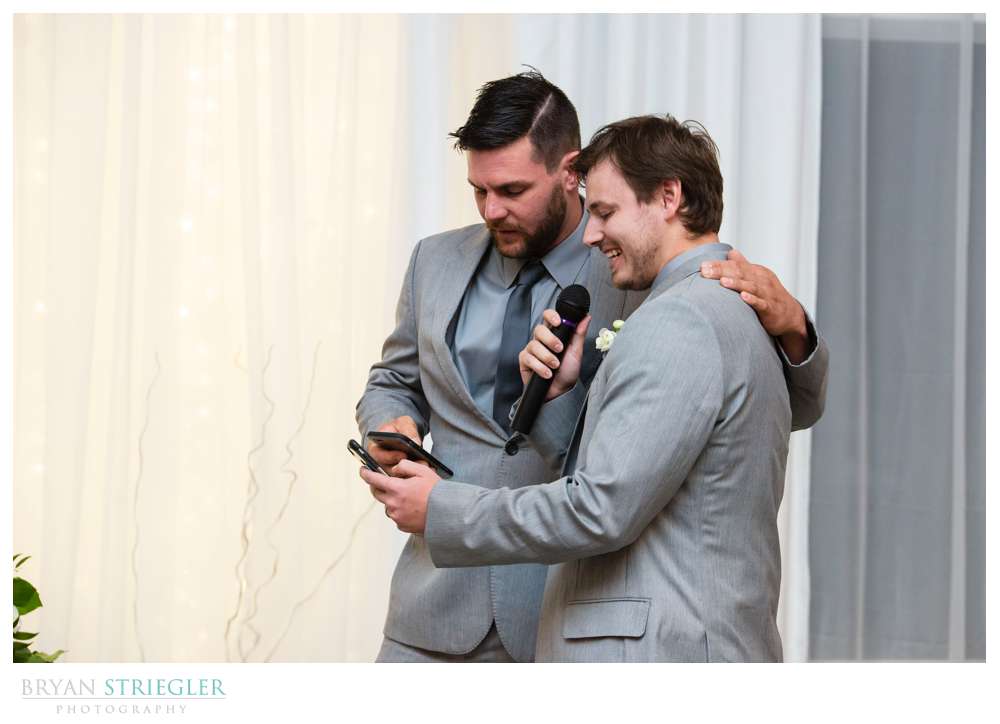
Adding Personal Touches to Your Best Man Speech
Share stories about the groom.
People are wired for stories. Sharing a story is the best way to keep the audience entertained and connected. I know I personally pay more attention when someone in the wedding party is telling a story. Share funny, heartwarming, or even embarrassing experiences that really show who the groom is and your relationship with him.

I’d suggest thinking of your own stories, but also asking mutual friends. Most likely there are some great stories you all shared that you might not remember.
Share what the Groom means to you
There is a reason you were chosen to be the best man. You have some sort of past and relationship with the groom. Make sure to express all the things you like about him and what he means to you. This could be that he’s always had your back, gives great advice, or a bunch of other things.
Tips for Delivering a Stellar Best Man Toast
Practice as much as possible.
I’ve seen groomsmen and other people wing a speech before. I’d say 95% of the time it doesn’t go well. Occasionally, you’ll have that person that is a natural speaker and entertainer, but that is rare. Your best bet is to prepare something early on, and practice it as much as possible.
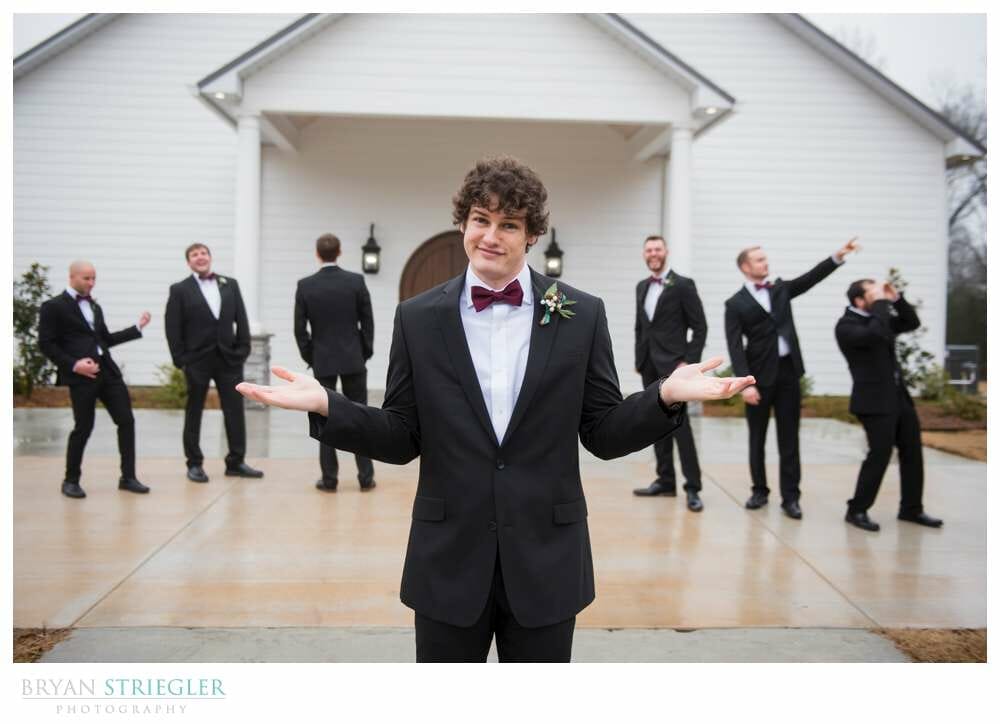
Rehearse your speech multiple times to familiarize yourself with the content, timing, and flow. Practicing in front of a mirror or with a trusted friend can help you refine your delivery for a polished performance. Remember, the more you practice, the more confident you’ll become.
Calming Yourself Before You give the Speech and During
Practice is a great way to get ready for giving the speech. I promise you will feel better if you practice versus if you didn’t. Still, you might feel a little nervous before you give the speech.

There are a few things you can do right before or even while giving the speech to calm your nerves. For some, having a drink or two before will help. This can also lead to disaster, so be careful. Take deep breaths and slow down. When you focus on breathing, you won’t focus on other things and you will relax. Visualize yourself as someone that is a great speaker and is killing it. Just seeing yourself that way will help.
Connect with the Audience
The wedding day and the speeches are for the couple, but they are also for all the guests. Make sure to connect with them. This means maintaining eye contact, speaking clearly, using hand gestures, and express your emotions genuinely. Even the best speech will lose its power if you’re looking at the ground and mumbling.
Keep It Short
I remember one time I sent my video people to a wedding while I was at another one. When I started going through the speeches, I nearly lost it. The bride’s dad went on forever. I’m not kidding. The whole speech was probably 50 minutes long. I could only imagine how the wedding guests felt.

There isn’t a set time limit for speeches, but in general, shorter is going to be better. I’ve yet to hear people complain that a speech was too short. I’d say aim for 4-7 minutes.
Addressing the Happy Couple and Wishing Them Well
With all the fun stories and things you will be sharing, don’t forget to talk directly to the couple. Toward the end, make sure to look at them and wish them a happy future and life together.
Then, it’s time to make the actual toast. With the toast, you can actually come up with something clever to say or you can ask everyone to lift their glasses and say “to the couple.”
Mastering the Art of Best Man Speech
Public speaking is hard for most people, but when you make it at a wedding, it’s even more stressful. Keep your speech focused on the things that matter, add some personal touches, and practice, and you’re speech will be something everyone remembers…in a good way!
Share this post
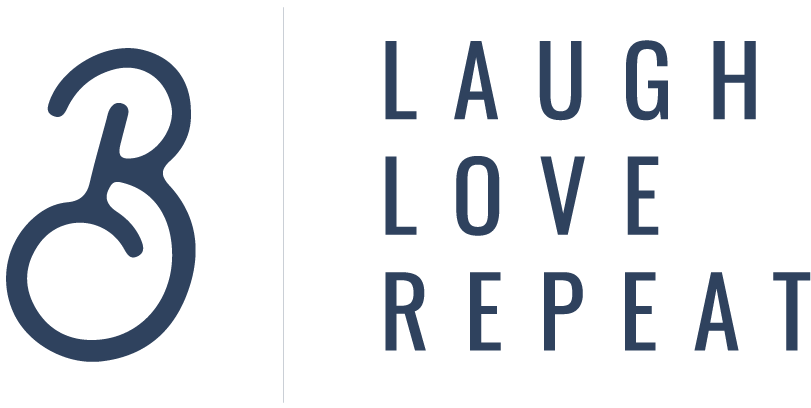
HELPING COUPLES LAUGH TILL IT HURTS
Capturing the feeling of home arkansas and beyond, follow along.

WE WEDDINGS
COPYRIGHT 2020, STRIEGLER PHOTOGRAPHY, ALL RIGHTS RESERVED | BRANDING & WEBSITE BY POSITIVELY CREATIVE
My Speech Class
Public Speaking Tips & Speech Topics
169 Five-Minute Topics for a Killer Speech or Presentation

Jim Peterson has over 20 years experience on speech writing. He wrote over 300 free speech topic ideas and how-to guides for any kind of public speaking and speech writing assignments at My Speech Class.
There are pros and cons to giving a 5-minute presentation. One good thing is the length. Long presentations can easily become boring, and you have a much better chance of keeping your audience engaged from beginning to end than with a 5-minute speech.
In this article:
Food & Drink
Relationships, social media, supernatural, list of topics for a 5-minute speech or presentation.

Choosing a topic is extremely important. To help you getting started, here is a list of some killer topics for 5-minute speech or presentation.
- Why it’s better to adopt a pet from a shelter
- Choosing the perfect leash for your dog
- What is the best food for your pet?
- How much exercise does your pet need?
- The horror of puppy mills
- Bringing back endangered species
- How long are giraffes in labor
- Domestication of horses
- Picking the right vet
- Sleeping with your dog
- Why should you get goats in pairs
- Ethics of zoos
- The domestication of dogs
- How to keep a goldfish alive for a long time
- How to choose the right pet
- Why cats are so independent
- When to get a dog
- What kind of dog is best for a household with children
- Why therapy animals work
- How to find the money to go to college
- How much control should the federal government have over curriculum design?
- How to choose a college
- Ideas for narrowing down a career choice
- When to declare a major
- Benefits of charter schools
- Why charter schools are bad
- Negative effects of school vouchers
- Attracting the right people to the teaching profession
- Discipline in the classroom
- Memory tricks that work
- Why homework is bad
- Should students still have to use the books in the library?
- Why cursive should still be taught in schools
- Textbooks vs. tablets
- Benefits of going to a trade school
- Are there positives to taking a gap year?
- The problem with low teacher pay
- Social media in the classroom
- Benefits of integrating apps into the classroom
- The importance of attachment
- How to compromise on names for your kids
- What is the ideal age to start a family
- How important are grandparents
- Traveling with children
- Strategies for potty training
- How to help a child with nightmares
- Middle child syndrome
- How many kids should you have?
- How to recognize a gifted child
- When your child doesn’t like to eat
- How to encourage good eating habits
- When to intervene with a bully
- Being active in your child’s school
- The benefits of aunts and uncles
- When family falls apart
- The first days with a new baby
- When to call the doctor
- Caring for an ailing parent
- Balancing home and career
- When to start saving for retirement
- IRA vs. Roth IRA
- When should you start saving for your children’s college education?
- Crowdfunded loans vs. the bank
- How Kickstarter changed everything
- Using your HSA
- How to apply for a mortgage
- Improving your credit score
- How to negotiate a raise
- Renting vs. buying
- How does compound interest work?
- How to ask for a promotion
- When is it time to get a new job?
- What to do when you find out a coworker makes more than you
- How much of a down payment on a house do you really need?
- Living on minimum wage
- Is it better to lease or buy a new car?
- How to budget for a new car
- What to do when you lose your job
- Using credit cards responsibly
- Is rare meat safe?
- Vegan vs. vegetarian
- Microbrews vs. standard brewing
- How to make your own wine
- What are hops?
- Best plants for a backyard garden
- When to transplant sprouts
- Bananas and plantains
- How to make a brine for pickling
- Where did brunch begin?
- Why pineapple belongs on a pizza
- When to order in
- Planning a menu
- Meal planning and grocery lists
- Is free range really better?
- The perfect macaroni and cheese
- Growing your own herbs
- How to make your own pasta
- How to make cookies that are softer
- Benefits of drinking black coffee
- Benefits of a gluten-free diet
- Is the paleo diet accurate?
- Effects of not getting enough sleep
- Are meal subscription services worth it?
- Downsides to Crossfit
- Benefits of yoga
- How to meditate
- Can therapy change the way your mind works?
- Are GMOs really dangerous?
- The truth about diet soda
- Importance of hydration
- Why cleanses don’t work
- Best juice diet
- Most effective exercise for burning calories
- Do essential oils really work?
- The history of television
- When the railway was king
- Thwarted assassination attempts
- The first Olympics
- Media during World War II
- Military advancements between World War I and World War II
- War photographers
- Things you didn’t learn in history class
- Historical lies
- The early Internet
- Why podcasts are great
- Most unbiased news channel
- When do people tune into the news most
- How relevant are women’s magazines?
- Cable vs. Netflix
- How worried should you be about your browsing history?
- How to limit screen time
- Why it’s bad to use your smartphone right before bed
- Apple vs. Android
- The best age to get married
- How to get an amicable divorce
- Finding a roommate
- Splitting financial responsibilities evenly among the household
- How to have a happy marriage
- Choosing your family
- How to fight effectively
- Signs of an abusive relationship
- What to look for in a spouse
- When to let it go
- How to overcome self-doubt
- Faking confidence
- Becoming comfortable with yourself
- How to say no
- Relaxation techniques
- Controlling anxiety
- Qualities of a leader
- The importance of self-care
- Identifying triggers
- How to eliminate negativity
- Making new habits
- Ethics of posting pictures of your children on social media
- How Internet ads are tailored to you
- How to advertise your business on Facebook
- Privacy and social media
- How to protect your personal information
- When to allow your kids to get their own social media accounts
- Why you shouldn’t post your location on social media
- How to use a hashtag
- Uncovering Twitter Bots
- Snapchat etiquette
- Proof that aliens exist
- Debunking crop circles
- Is Bigfoot real?
- Proof that ghosts exist
Good 2-Minute Speech Topics for Students
13 All-Time Best TED Talks
23 thoughts on “169 Five-Minute Topics for a Killer Speech or Presentation”
Ideal Teacher
is life really a blessing?
This has helped me so much for my English class thank you!
Why personal (private) rules are helpful
I got an A!!!!!
Risks of abortion Wage gap How social media impacts education/mental health Why it’s important to have a good stable mental health Do teenagers really spend all their time on their phones Gsce requirements unfair or reasonable
Here is a kind of a dense topic, domestic abuse. Why does it happen? What are some ways to identify a abusive relationship? How does it affect families? Why is the abuser abusive?
We have presentation next week. I can’t think about the topic. Please help me!
i want a topic that involves supernatural: HELP
Is water wet?
death, what if the earth loses air entirely for five minutes, what is the most common death.
I have presentation next two day concerning with my classroom. I must choose five topics but i can’t think how to choose these topics. Please! help me
Tanks for giving me an A in drama
so helpful thank you
thanks this helped with my speach at school
i need a best topic to present on that is educational to consumer science and food nutrition students. can i please be assisted
what if the earth stopped spinning pros and cons of being an artist how Gen Z affected slang why people are afraid of the dark why knowing how to play an instrument is beneficial/not needed
Here’s a controversial one: are trans, intersex and non-binary people getting the same right as every else?
I have a presentation this week I don’t understand how to find a good title please help me I’m a diploma student the speech must have more than 10 minutes
How do create presentation for famous place in Sri Lanka
i need something for my oral communication class. it must be attention grabbing and not an argument. please help
I need ideas on a slide show presentation, a kid appropiate topic.
Pls I need more ideas on self help
hi lol i like these topics but i need a trendy one like something new or like a natural phenomene or someth like that… 🙂
Leave a Comment
I accept the Privacy Policy
Reach out to us for sponsorship opportunities
Vivamus integer non suscipit taciti mus etiam at primis tempor sagittis euismod libero facilisi.
© 2024 My Speech Class
How to Start a Speech: The Best (and Worst) Speech Openers
Subscribe to our weekly newsletter.
One of the hardest things about public speaking is knowing how to start a speech. Your opening line is your first impression. It’s how you capture attention. It’s how you captivate the audience. So how do you make sure you nail it every time?
The best way to know how to open a speech is to look at what has worked in the past. When we examined the top speeches of all time and the most popular TED talks of all time, we found some interesting speaking patterns.
Time has identified the top 10 greatest speeches of all time. They are:
Opening Lines of the Top 10 Greatest Speeches of All Time
#1: Socrates – “Apology”
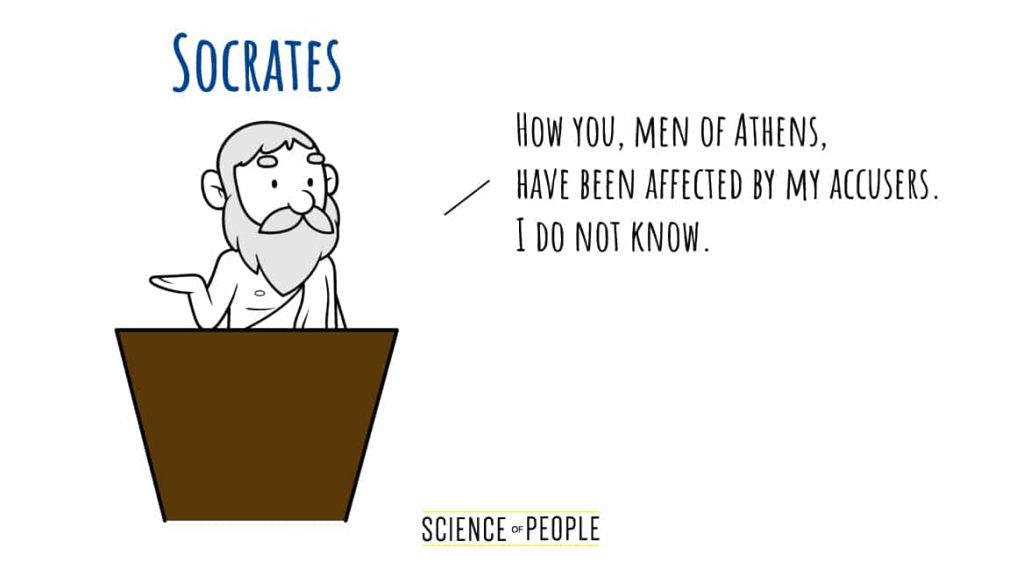
#2: Patrick Henry – “Give Me Liberty or Give Me Death”
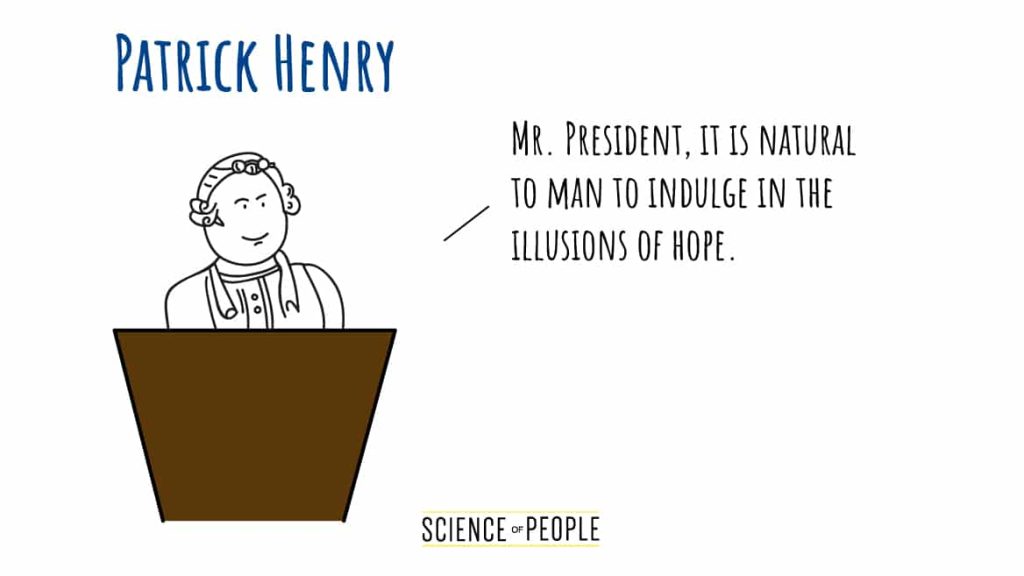
#3: Frederick Douglass – “The Hypocrisy of American Slavery”
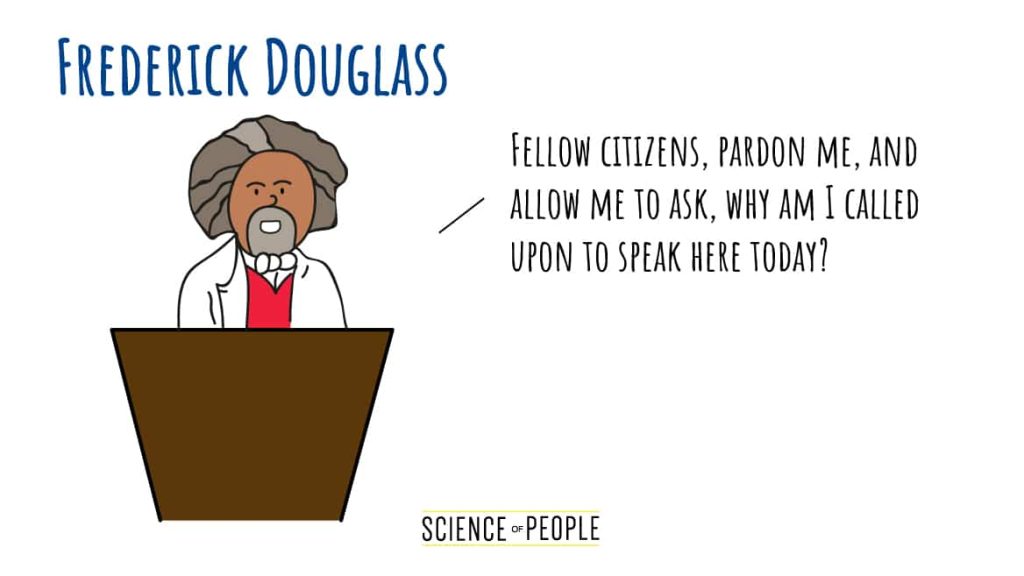
#4: Abraham Lincoln – “Gettysburg Address”
Opening Line: “Fourscore and seven years ago our fathers brought forth on this continent a new nation, conceived in liberty and dedicated to the proposition that all men are created equal.”
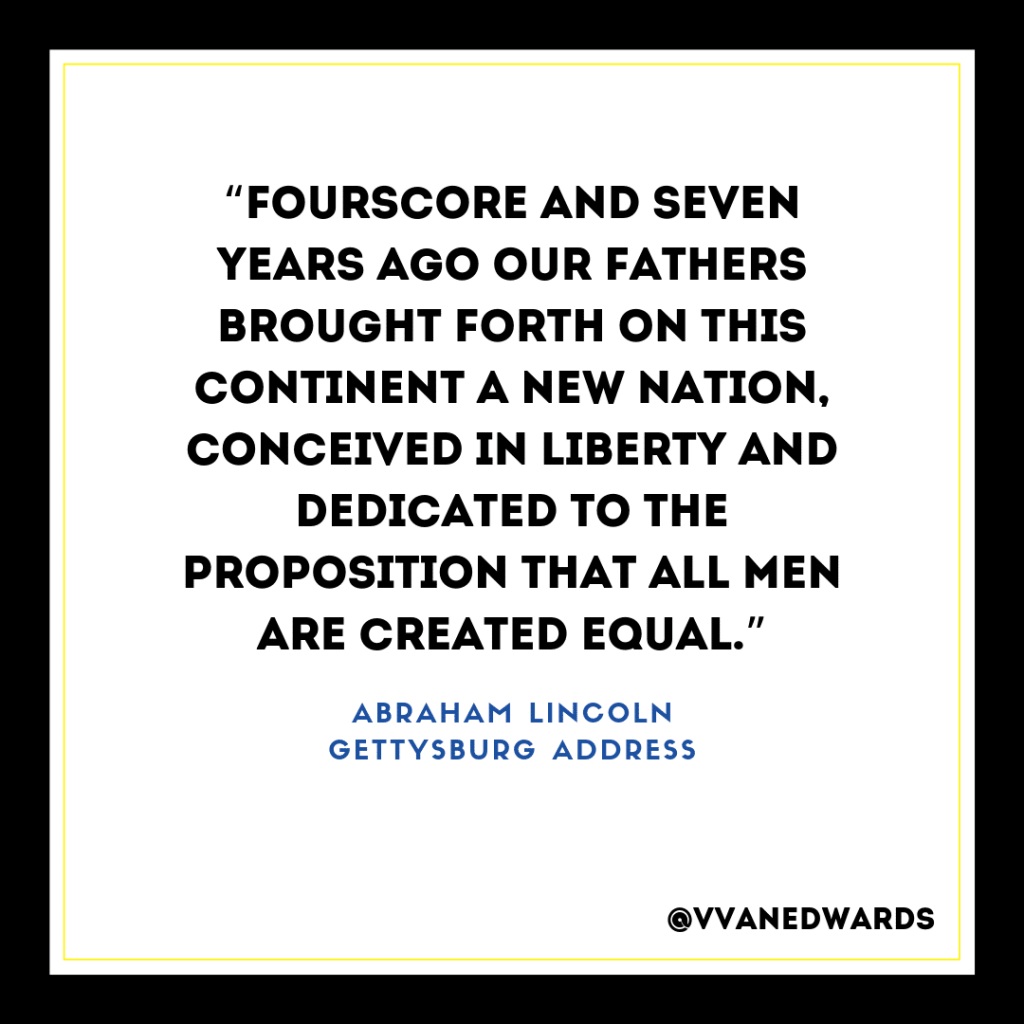
#5: Susan B. Anthony – “Women’s Rights to the Suffrage”
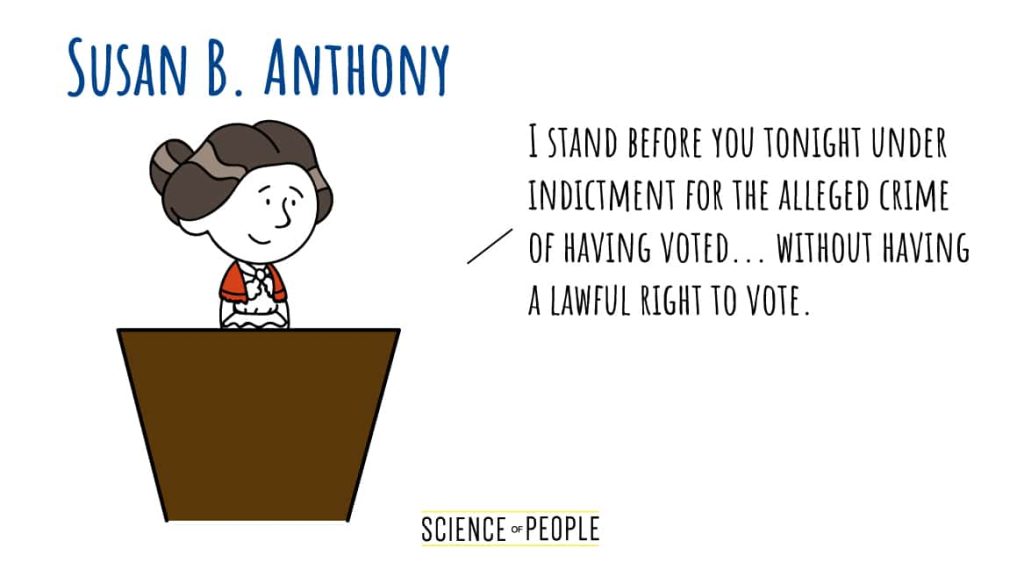
#6: Winston Churchill – “Blood, Toil, Tears, and Sweat”
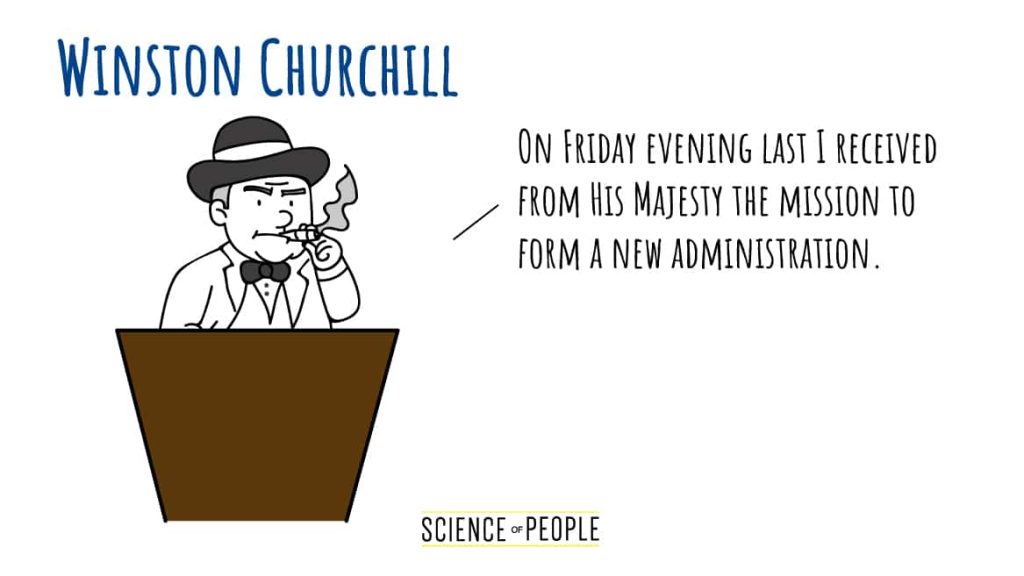
#7: John F. Kennedy – “Inaugural Address”
Opening Line: “We observe today not a victory of party, but a celebration of freedom — symbolizing an end, as well as a beginning — signifying renewal, as well as change.”
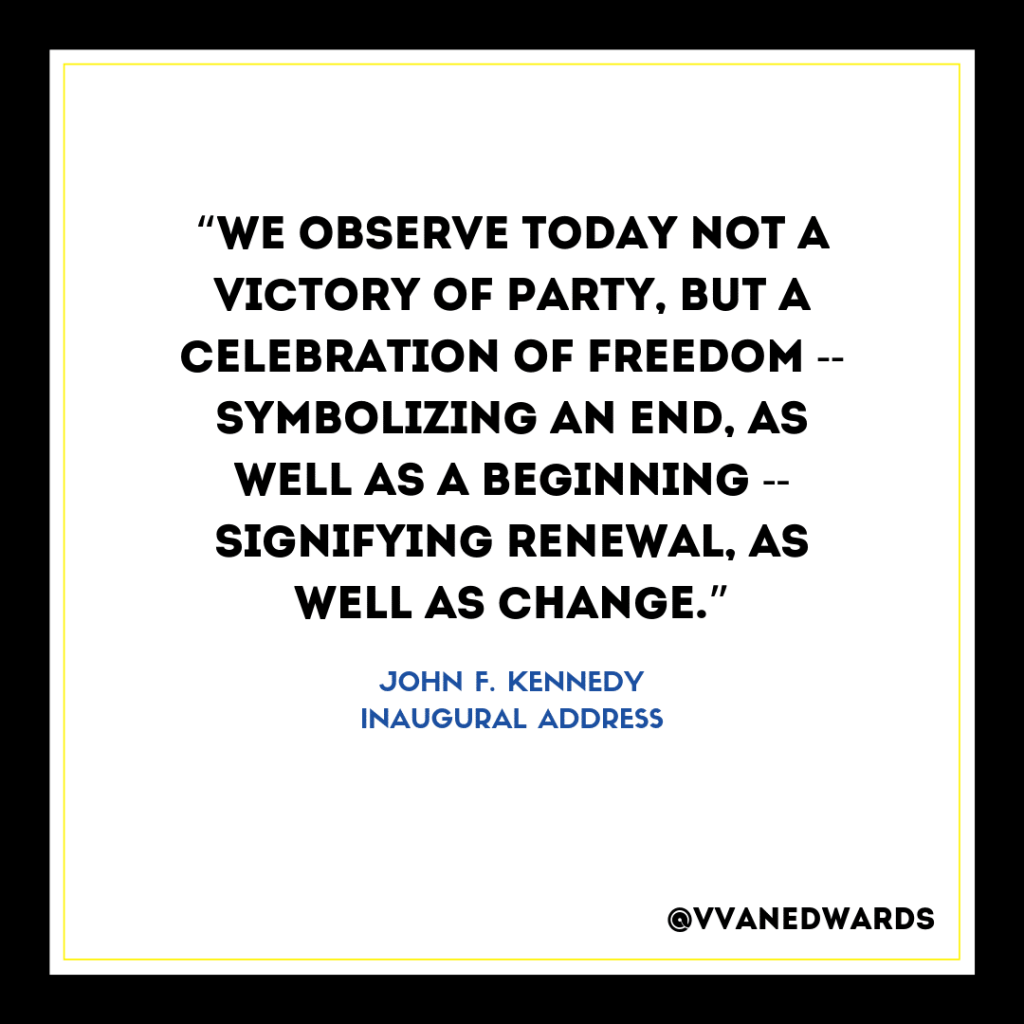
#8: Martin Luther King, Jr. – “I Have a Dream”
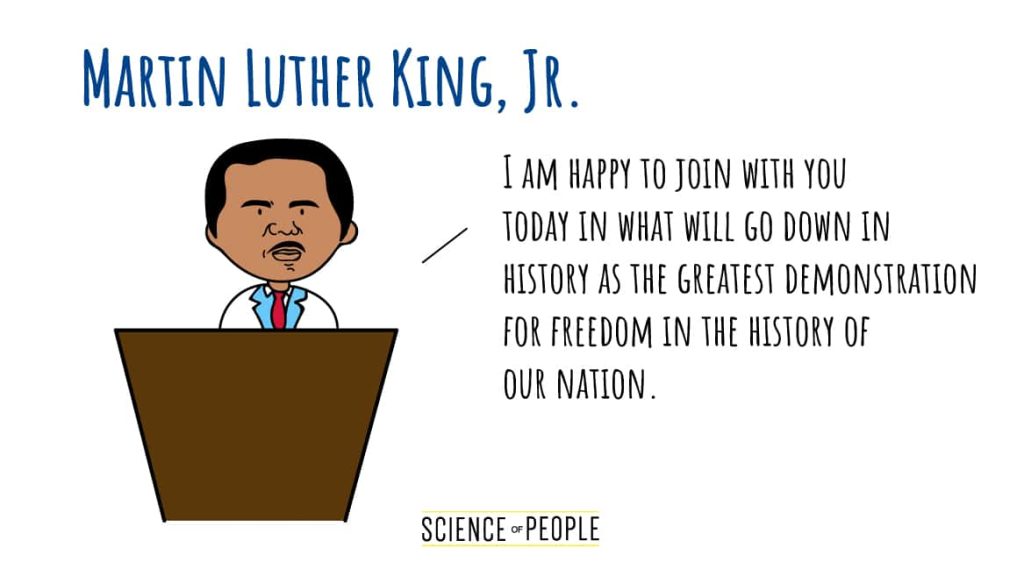
#9: Lyndon B. Johnson – “The American Promise”
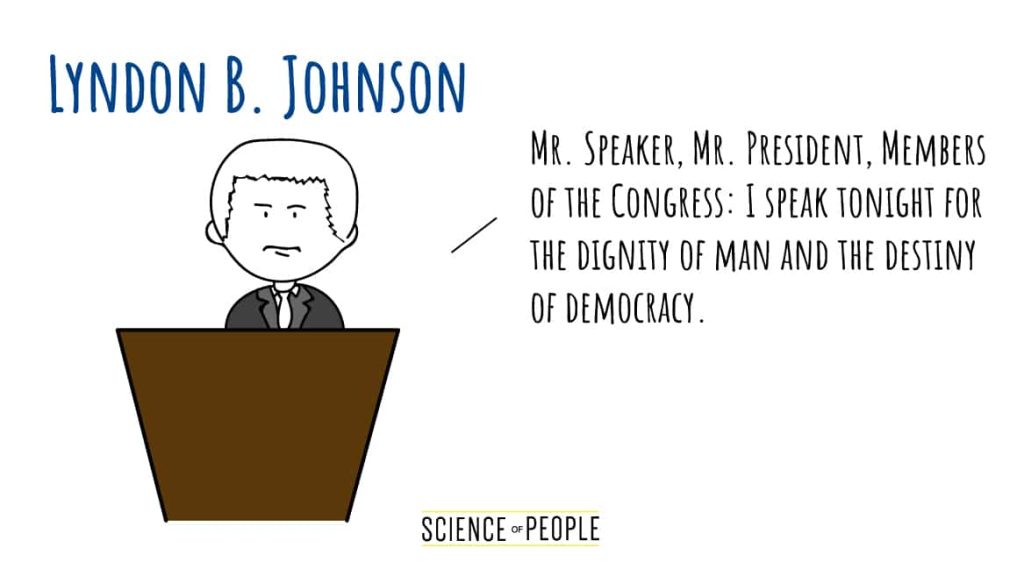
#10: Ronald Reagan – “Remarks at the Brandenburg Gate”
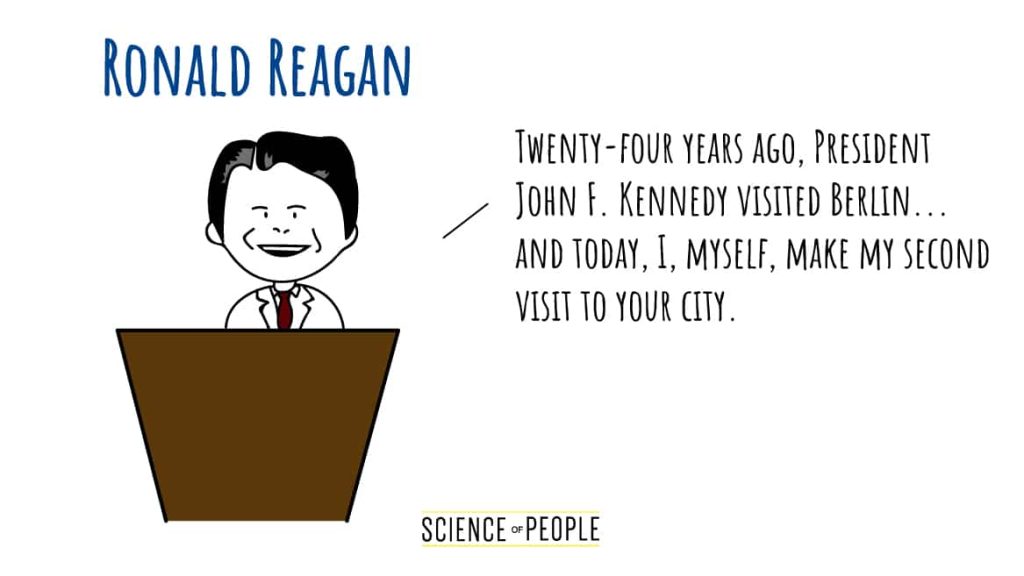
How do all of these historical greats start their speeches? Is there a difference between these and some of the more modern top TED talks?
Before we dive in, let’s recap with some critical do’s and don’ts when opening a speech:
Opening Lines of the Top 10 TED Talks of All Time
Here are the opening lines to the top 10 Ted Talks of all time according to view count:
#1: Sir Ken Robinson – “Do schools kill creativity?” Opening Line: “Good morning. How are you? It’s been great, hasn’t it? I’ve been blown away by the whole thing. In fact, I’m leaving.”
#2: Amy Cuddy – “Your Body Language May Shape Who You Are” Opening Line: “So I want to start by offering you a free, no-tech life hack, and all it requires of you is this: that you change your posture for two minutes.”
#3: Simon Sinek – “How Great Leaders Inspire Action”
#4: Brene Brown – “The Power of Vulnerability” Opening Line: “So, I’ll start with this: a couple years ago, an event planner called me because I was going to do a speaking event.”
#5: Mary Roach – “10 Things You Didn’t Know About Orgasm” Opening Line: “All right. I’m going to show you a couple of images from a very diverting paper in The Journal of Ultrasound in Medicine.”
#6: Julian Treasure – “How to Speak so that People Want to Listen” Opening Line: “The human voice: It’s the instrument we all play.”
#7: Jill Bolte Taylor – “My Stroke of Insight” Opening Line: “I grew up to study the brain because I have a brother who has been diagnosed with a brain disorder: schizophrenia.”
#8: James Veitch – “This is What Happens When You Reply to Spam Email” Opening Line: “A few years ago, I got one of those spam emails.”
#9: Cameron Russell – “Looks Aren’t Everything; Believe Me, I’m a Model” Opening Line: “Hi. My name is Cameron Russell, and for the last little while, I’ve been a model.”
#10: Dan Pink – “The Puzzle of Motivation” Opening Line: “I need to make a confession at the outset here.”
What can we learn from these opening lines? There are some patterns that can help us. First, let’s start with what you shouldn’t do. Have you ever made one of these cardinal speaking sins?
Never Start a Presentation with…
Anything technical! This is a big mistake people make when they have not done a tech check ahead of time or are feeling nervous. Never start with these openers:
- Is this microphone working?
- Can you hear me?
- Wow, these lights are bright!
Your nervousness. Many people think it is vulnerable to start with how nervous they are about speaking — you can mention this later, but it should not be the first thing. Why? People will then only be looking for signs of your nervousness. Don’t start with:
- I’m so nervous right now!
- Wow there are so many people here.
- I’m not a great public speaker.
A lackluster or non-believable nicety. It’s great to be grateful to the person who introduced you, but it’s not a great way to include the audience. It’s ok to thank the audience for being there—but do it at the end (not as your opening line). These are all too boring:
- Thanks for having me.
- Thanks for that intro.
- Nice to be here.
Boring, shmoring! I have an exception here if you can make it funny. Ken Robinson started with a nicety and then turned it into a joke. He said, “ “Good morning. How are you? It’s been great, hasn’t it? I’ve been blown away by the whole thing. In fact, I’m leaving.”
More Public Speaking Resources
Get even more public speaking tips with our related resources:
- 10 Presentation Ideas that will Radically Improve Your Presentation Skills
- 6 Public Speaking Apps to try Before Your Next Presentation
- My Top 5 Favorite Public Speakers
- 15 Science-Based Public Speaking Tips To Become a Master Speaker
- How to Give Captivating Presentations
- How to Give an Awesome Toast
How to Start a Presentation
A story. The absolute best way to start a presentation is with a story. There is nothing better to capture the imagination and attention of an audience. Try to use these speaking openers as fill-in-the-blanks for your speech.
- I’m here for a reason. And it’s an interesting story…
- The best thing that ever happened to me was…
- Once upon a time…
In his talk, “The lies our culture tells us about what matters,” David Brooks started off with a great opening line AND a story. He said, “So, we all have bad seasons in life. And I had one in 2013. My marriage had just ended, and I was humiliated by that failed commitment.” Makes you want to watch right…
And if you need help on storytelling basics, be sure to check out some of my top 5 favorite speakers .
A BIG idea. Sometimes you want to share your big idea right up front. This can be helpful because it is intriguing and gets people clued in right away. All TED speakers try to integrate their big idea early.
- You’re here for a reason. It’s…
- The single most important thing I want to share with you today is…
- Today, I want to share a big idea…
I love how Stacy Smith starts off her talk with her big idea framed in an interesting way. She said, “Today, I want to tell you about a pressing social issue. Now, it’s not nuclear arms, it’s not immigration, and it’s not malaria. I’m here to talk about movies.”
Special Note: Be very careful to NOT deliver your one-liner by re-reading your title slide. You also want to position it as exciting and intriguing. For example, don’t say, “Today I am going to talk about body language.” Instead say, “Today I am going to teach you the single most important thing you can do to improve your charisma… and it starts with your body.”
A quirky one-liner. If you can use humor — do it! Humor or curiosity is a great way to start a speech on a high. You can get creative with these! Think of an interesting fact about you, your audience or your topic that can lead you into your content.
- One thing most people don’t know about me is…
- A teacher, a mother and a duck walk into a bar…
- I want to tell you something surprising.
When I gave my TEDx London Talk I started off with a quirky one-liner that immediately got a few laughs. It was “Hi, I’m Vanessa and I am a recovering awkward person.” It worked so well it is also the first line of my book, Captivate .
II love the way Eve Ensler opens her speech with an interesting one-liner: “For a long time, there was me, and my body.”
This is a great tip from Conor Neill. He says that it is great to start with a question that the audience is asking themselves or would be very curious to know the answer to. This might be phrasing a pain point or worry for your audience.
- Do you ever worry about…?
- Have you ever wondered…?
- You might have always thought…
See Cono Neill’s examples here:
Did you know…? Any interesting factoid or curiosity is bound to intrigue your audience. This is great if it leads into your content or a story. I like to start with did you know… Here are some that I use. You will have to fill in the blank for your audience:
- Did you know that it takes less than a second to make a first impression ?
- Did you know that your nonverbal communication is 12.5 times more powerful than your words ?
- Did you know that we are lied to 200 times a day ?
Jamie Oliver does this amazingly in his TED Talk. He starts with this mind-blowing fact, “Sadly, in the next 18 minutes when I do our chat, four Americans that are alive will be dead through the food that they eat.”
Hopefully these opening lines will give you some ideas to use to open your speech.
How to End a Speech: My Favorite Closers
Do you know how to end on a high? Leave a lasting impression in your presentation? Science tells us that the first and last parts of your presentations are the most important. Get our FREE download to get our closer guide.
Popular Guides
20 thoughts on “how to start a speech: the best (and worst) speech openers”.
Love your material
didnt help me but still good stuff
Thank you Vanessa. I’ve been a public speaker for 25 years and I’m impressed with your content here. Thank you. Looking forward to a deep dive into more of your material. With gratitude.
Found these examples super informative. Can’t wait to mix match the examples to see which one will work best for my presentation!
I am preparing to make a presentation on Public Speaking and came across your article. This is very instructive and timely too.Many thanks.
Comments are closed.
How to Deal with Difficult People at Work
Do you have a difficult boss? Colleague? Client? Learn how to transform your difficult relationship. I’ll show you my science-based approach to building a strong, productive relationship with even the most difficult people.
Related Articles
Science of People offers over 1000+ articles on people skills and nonverbal behavior.
Get our latest insights and advice delivered to your inbox.
It’s a privilege to be in your inbox. We promise only to send the good stuff.
- My Account My Account
- Cards Cards
- Banking Banking
- Travel Travel
- Rewards & Benefits Rewards & Benefits
- Business Business

Advertisement

Related Content
7 tips for giving a great speech.

Published: July 05, 2022
A great speech presents clear, relatable content in an engaging way. Use these seven techniques to calm your nerves and prepare for giving a great speech.
Whether it's designed to share a brand message with an unfamiliar crowd or to inspire employees during difficult times, a great speech can prove to be a critical tool in a business leader's communication toolkit.
What Makes a Great Speech?
One of the most important qualities of a great speech is that it’s relatively short.
Consider Abraham Lincoln’s “Gettysburg Address” and Dr. Martin Luther King, Jr.’s “I Have a Dream” speech. Both are powerful but brief, clocking in at two minutes and 17 minutes, respectively.
However, a speech’s length is only one factor. A great speech must also captivate the audience, be presented clearly and confidently, and have a well-defined message.
Here are some techniques you can use to deliver a great, memorable speech, whether it's for work or elsewhere.
1. Consider Your Speech a Performance
A speech is primarily about the words, but a performance is so much more. It’s inflection, gesture, tension, resolution, and suspense.
But it doesn't have to be overwhelming, and you don't have to be an Oscar winner to do it well.
Go see a one-person play, and you’ll instantly understand what I mean. Performers work hard at capturing and keeping an audience’s attention , and words are only one tool in their arsenal.
This means after you finish writing a speech, the work isn't done. Make sure to rehearse the speech in front of a few people, the mirror, or a recording device. You'll feel more confident after you've practiced, even if it's just a few times.
2. Harness the Power of Eye Contact
When nerves take over, you might naturally want to look at the floor, your slides, your hands, or the back of the room. But remember that you're in a room with humans who want to connect with you and your words.
If you try to make eye contact with people while you deliver your speech, they're more likely to feel personally engaged and gain your trust. Eye contact communicates confidence and authority – two traits key to conveying your point effectively.
3. Let Go of the Lectern
The lectern can be a crutch. It’s a physical barrier between you and your audience, and you may want to consider stepping out from behind it. Not only will your movement help create a livelier presentation, but it will help the audience perceive you as more open and accessible. Movement can also help ease your nerves.
To help you stay focused when delivering your speech, map out where you want to be on stage for each key point you want to make. You can record videos of your practice sessions to pick up on subconscious nervous gestures or ticks and work to correct them.
4. Pay Attention to Your Posture
Your body language conveys confidence . Slouching can make you look like you aren't confident. Practice standing up straight, keeping your shoulders back and your head steady. However, don't worry too much because your body will tighten, making you look and feel nervous. Remember to relax.
Additionally, breathing is important for calming your nerves. Slouching leaves less room for your lungs to fully breathe. Even if your speech is short, it’s critical to optimize your breathing habits so you feel better both mentally and physically.
Take deep, calm breaths as much as you need to beforehand. Don't forget to pause and breathe during the speech too. Taking care of yourself is crucial.
5. Spice Up Your Speech with Stories
The power of storytelling lies in the images that audience members create in their heads as you spin your yarn.
Try not to overload your speech with data points, unless it's primarily a data-driven topic. Listeners will be more likely to remember pertinent anecdotes that inspire compassion, elicit laughter, or simply intrigue them.
Stories – especially brief, relevant ones – are a powerful tool for delivering a great speech. Weaving them into your presentation can transform your listeners into active participants.
6. Vary Your Speaking Cadence
When delivering a speech, it’s important to deliberately mix up speaking patterns such as volume, speed, and tone.
When in doubt, slow down your speech to let your audience catch up – especially if you tend to speak quickly. Remembering to pause can be very helpful in steadying the speech.
If you know you’re naturally a fast talker, build some pauses into your speech. Determine points at which to take a breather, or incorporate statements like “Now think about that for a moment” or “Let that sink in.” It takes an audience more time to process your points than it will take for you to articulate them.
Remember that you're the expert. Give people time to ponder your brilliant message.
7. Discuss What You Know and Care About
If you're asked to give a speech, you're probably already an expert on the subject.
Passion translates to energy and authenticity, which help engage an audience. Emotion pulls the audience in and gets them invested in hearing more. Take them with you on this journey from the start by talking with passion.
If you find you’re not moved by your topic, modify it so it's more relevant to you and your audience. The more relevant it is, the more engaging your speech will be, and the more confident you'll feel delivering it.
As an expert worthy of giving a great speech, you'll likely excel at providing the main content points. But using these techniques can help you get your message across in a compelling and memorable way. Focus on crafting a clear, concise message that’s rife with relevant anecdotes. Practice the performance, adjust any small habits as needed, and remember that you deserve to be up there. Remember to breathe.
A version of this article was originally published on September 08, 2014.
Photo: Getty Images
Trending Content

How to Write a Killer Maid of Honor Speech: The Ultimate Guide

Disclosure: This post contains affiliate links, meaning we earn commissions if you shop through the links below. As an Amazon Associate, I earn from qualifying purchases. Please read my disclaimer for more info.
To us here at Modern MOH, the writing and delivery of the maid of honor speech is the most sacred duty of them all. We feel this is your true time to shine and the greatest opportunity to show your bestie just how much her happiness means to you. By taking the time to construct a heartfelt and well-written speech, then delivering it to the best of your ability, you will help make your bride’s wedding day all the more perfect.
And while we doubt we were your first stop on the “ how to write a maid of honor speech ” search train, we do hope to be your final destination. You see, unlike most articles you’ll find on the subject of maid of honor speeches, we’re actually going to give it to you straight. No vaguely basic outlines or generically boring examples, just the cold hard facts.
Because we have some serious experience in the toast department, and if there’s one thing we’ve learned about writing a killer maid of honor speech, it’s this: there is no secret formula, no one best way . How could there be? Each and every relationship between a maid of honor and a bride is different from the next, just as each and every memory is uniquely yours.
Lastly, we know the thought of having to give a wedding toast in front of a large group of people may be terrifying for most, that’s why we’re here to teach you a thing or two to ease those nerves. From start to finish, we have all the tips and tricks you need to know to bring the house down.
How to Write a Maid of Honor Speech in 5 Simple Steps
1. define your overall objective.
Before you begin writing your maid of honor speech, you must first define your objective. In other words, you need to have a goal you’re looking to accomplish. For example, are you hoping to make wedding guests laugh? Cry? Both? Do you want to talk about your history with the bride, about how you met the groom, or what their relationship as a couple means to you?
Knowing the answers to these questions will help you figure out the direction you should take when writing your wedding toast.
If you find yourself struggling to define your objective, simply think of your relationship with both the bride and groom. Do they have a great sense of humor? Is your time together spent mostly joking around and laughing? If so, try taking a comedic approach to your toast by cracking a few funny jokes along the way.
Or maybe you and your bride have been through some very serious times together that you want to share, in which case your speech may be much more emotionally moving. The great part about this objective is that it’s your own, so there is no one right or best way to go about it.
MODERN MOH TIP: Touch on a little bit of everything. Start strong with a joke or two and finish out with a sentimental toast. While there is no exact formula to it, a truly good maid of honor speech is both funny enough to get wedding guests laughing and moving enough to bring a tear to their eye. Secondly, don’t spend so much time talking about your history with the bride that you forget to talk about the groom. Even if you don’t have your own personal memories with your best friend’s new hubby, that doesn’t mean he should be left out of your speech. Instead, talk about their relationship as a couple and what it means to you, including your wishes for the bride and groom’s future together.
2. Decide on Your Point of View
The key to writing a killer of maid of honor speech is to not think of it as a speech, but instead a story. And as the narrator of this particular story, it’s up to you to determine the point of view from which you tell it. While it may seem obvious that you’d write from the first-person POV, there are definitely some benefits to switching it up.
To begin with, writing from a third-person POV will give your toast a unique twist and a more story-like feel. For example, instead of saying “Taylor and I met on the school bus in the third grade and she’s been my best friend ever since” , you could say “When Taylor was in the third grade, she met a little girl on the school bus who remains her best friend to this day” .
Like the idea, but don’t think you can write an entire speech that way? No problem. Unlike what you were taught in grade school, you have the freedom to switch between differing points of view when telling your story. If you haven’t caught on yet, let us reiterate: there is no right or wrong when it comes to writing your speech.
MODERN MOH TIP: Take advantage of switching up points of view. Start with narrating from the first person point of view, especially if it’s easier for you to tell the history between you and the bride that way. When it comes time to talk about the couple, tell their story from an outsider’s perspective. If you do decide to go this route, don’t get so crazy with it that you start confusing your audience. The whole point of using different points of view is to enhance your maid of honor speech, not complicate it.
3. Determine Your Must-Haves
Now that you’ve defined your objective and decided on your POV, it’s time to determine your must-haves. By must-haves, we mean the anecdotes you absolutely want to include in your maid of honor speech. For instance, is there a particularly good memory you have with the bride that you definitely want to share with wedding guests? Or maybe you were there when the bride and groom met and you want to tell your side of the couple’s story?
Determining your must-haves before you begin writing your toast will guarantee you don’t forget to feature them. Not to mention, it will keep you from going off track when it comes time to put pen to paper. If you’re having trouble narrowing it down, keep this in mind: it’s much better to have one or two epic stories than a mix of mediocre ones.
MODERN MOH TIP: Don’t be that maid of honor that goes on and on about memories and “funny” inside jokes you have with the bride (no wedding guest wants to hear it, trust us). Instead, tell one or two really good stories that portray your friendship and then move on to her relationship with the groom and their history as a couple. Too many MOHs make the mistake of making their toast all about them and not enough about the couple whose wedding they are supposed to be celebrating. If you want to talk about yourself in front of a big audience, try Youtube.
4. Develop Your Story From Beginning to End
As we mentioned before, the key to writing a killer maid of honor speech is to tell it like a story. And just like any good story, you must develop it from beginning to middle to end (think along the lines of “ once upon a time ” to “ they lived happily ever after ”). While it’s entirely up to you to decide what constitutes the beginning, middle, and end of your particular story, you should avoid big jumps in time. In other words, do your best to develop it in chronological order so you don’t confuse wedding guests.
For instance: Start by telling the story of how you and the bride met, continue on with a memory you have of the bride and groom, and finish with a toast for the couple. Again, there is no magic formula when it comes to writing a maid of honor speech, but having a clear and concise storyline is highly suggested.
MODERN MOH TIP: Don’t be predictable. Chances are you and your best friend didn’t cross paths in some epic way (especially if you’re sisters), so skip the generic “this is how we met” story. Instead, dive right into a funny/crazy/holy s*$&! moment to get the crowd’s attention. And don’t be boring with your finale either. No generic “cheers to the Mr. & Mrs.” toast, we know you can do better than that. Your goal should be to receive a standing ovation from the couple and their wedding guests, not a polite golf clap.
5. Describe Your Characters in Detail
We can’t stress how important this final step is when it comes to writing your maid of honor speech. Seriously, taking the extra step to describe your characters in detail is what differentiates the bland from the bomb. And just so we’re clear, by characters we mean the bride and groom, and by detail we mean elaboration. For example, instead of saying “Taylor is such a great friend, she’s always been there for me whenever I needed her” , you should say “I’ve never met a more loving and loyal person than Taylor, she truly exemplifies what it means to be a best friend” .
These extra tweaks may seem insignificant to you, but they’re exactly the lines that will resonate with your audience and more importantly, the couple. And if writing isn’t your strong suit, don’t worry. Simply speak from the heart, you’ll be surprised at how well your final product turns out.
MODERN MOH TIP: Use a thesaurus (seriously, we do it all the time). It’s a good way to spice up your word choice and will stop you from repeating yourself. On the flip side, don’t feel like you have to use a ton of fancy words- you want to sound like yourself after all, not Shakespeare. Lastly, don’t be afraid to throw a bit of alliteration in there. It brings character to your writing and will make your toast much more memorable ( see what we did there? )
How to End a Maid of Honor Speech
Now that you’ve got the beginning and middle of your speech outlined, it’s time to work on your ending. As this will be your final moment with the mic, your goal should be to make it a memorable one.
One hard-fast rule on ending any maid of honor speech is to address both the bride and groom as a newlywed couple and offer your best wishes for a happy marriage. The easiest way to accomplish this is by raising a toast.
As far as the contents of your toast, it’s up to you if you want to use your own words or prefer to recite a heartfelt quote . To help you decide, ask yourself the following question:
If the answer is yes, by all means, write up your own personal toast. If the answer is no, start searching for the perfect quote.
MODERN MOH TIP: Select a few possible endings for your maid of honor speech and do test runs through them all to see which flows the best. Oftentimes it’s easier to decide based on how you deliver the words than how they sound in your head.
Have you checked out all our tips and still need help writing the perfect Maid of Honor speech?
Not to worry, Bridesmaid for Hire can help you craft an amazing, personal speech instantly!
Don’t believe it? Give it a try and see for yourself!
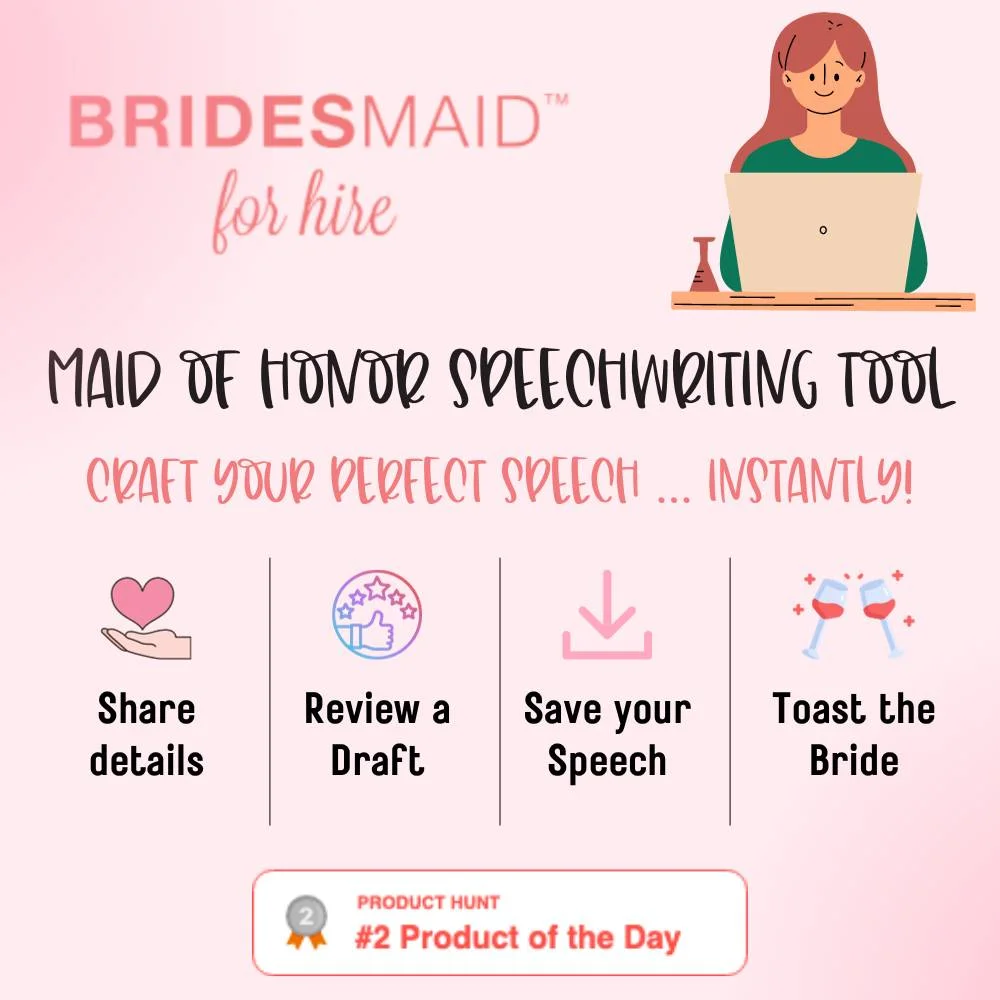
Pin for Later!

As an Amazon Associate, I earn from qualifying purchases.
GET STARTED
BRIDAL SHOWER
BACHELORETTE PARTY
BRIDESMAID STYLE
SHOP PRINTABLES
PRIVACY POLICY
AFFILIATE DISCLAIMER
SHOP POLICIES
OUR PARTNERS
MISS TO MRS BOX
UNCOMMON GOODS
THE ADVENTURE CHALLENGE
BRIDESMAID FOR HIRE
Review Cart
No products in the cart.
More From Forbes
5 quick steps to a killer ted speech.
- Share to Facebook
- Share to Twitter
- Share to Linkedin
- Editorial Standards
- Reprints & Permissions
‘The Shallow Tale of a Writer Who Decided to Write About a Serial Killer’ Review: A Lurid Comedy That Skips Past Its Best Ideas
John Magaro and Steve Buscemi shine in an otherwise dull affair.
By Siddhant Adlakha
Siddhant Adlakha
- ‘Hacking Hate’ Review: A Voyeuristic Documentary Infiltrates Online White Supremacy 4 days ago
- ‘Bad Actor: A Hollywood Ponzi Scheme’ Review: A Dull Documentary About a Fascinating Showbiz Grifter 4 days ago
- ‘The Shallow Tale of a Writer Who Decided to Write About a Serial Killer’ Review: A Lurid Comedy That Skips Past Its Best Ideas 2 weeks ago

“ The Shallow Tale of a Writer Who Decided to Write About a Serial Killer ” marks the English-language debut of Turkish director Tolga Karaçelik. Its initial premise, about an unhappily married couple, morphs and flips on its head until it transforms into something resembling the movie’s title, though it’s only about “a writer writing about a serial killer” in the most nominal sense. That one element gives way to an even more amusing conceit, involving crossed-wires and mistaken identities, but its wires continue to cross, until the movie mutates beyond recognition, refusing to stick to any one idea for longer than a couple of scenes.
Related Stories
Is netflix about to turn into a franchise factory, apple will add chatgpt to siri, iphone and other platforms for free, popular on variety.
The film’s music, by Nathan Klein, is mischievous and rooted in character specifics — its primal, visceral sounds tie into Keane’s in-progress Neanderthal romance novel, down to the writer mentioning a rudimentary flute — but the score never evolves to accommodate the movie’s shifting premise or subject matter. Each of its cast members brings a unique and specific flair that’s immediately undone by the film’s trajectory.
Magaro’s fearful insecurity as Keane is undercut by the eagerness with which he goes along with Kollmick’s ploys, leaving tremendous comedic potential on the table. Buscemi’s commitment to a comically methodical killer is similarly undone by how swiftly each situation goes awry, forcing Keane and Kollmick to approach each scene with an identically clumsy vibe (the comedy of contrast never seems to arise, despite being baked into the key dynamic). Meanwhile, Lowe’s sternness is diluted by what feels like a subplot that belongs to a much more fearful and less self-assured character who suspects her husband is up to no good. All these contradictions are in service of specific physicals gags and situations that play as though they were written before the characters were ever conceived, or were penned for an entirely different set of characters altogether.
It’s a comedy that feels written in reverse. Worse yet, it’s directed without any of the visual flair that a series of such zany premises might deserve. The result is a lethargically drawn-out movie with no verve or allure and none of comic spark of a film like Richard Linklater’s recent “Hit-Man,” which plays similarly with shifting identities and cascading scenarios.
Reviewed at Tribeca Film Festival (Spotlight Narrative), Jun. 8, 2024. Running time: 102 MIN.
- Production: A Curious Gremlin, Cinegryphon Entertainment production. Producers: Scott Aharoni, Sinan Eczacibasi, Alihan Yalcindag, Wren Arthur, Alex Peace-Power, Steve Buscemi, Tolga Karacelik, Mustafa Kaymak.
- Crew: Director, writer: Tolga Karaçelik. Camera: Natalie Kingston. Editor: Evren Lus. Music: Nathan Klein.
- With: Steve Buscemi, John Magaro, Britt Lower. (English dialogue)
More from Variety
Kelsey grammer on continuing the legacy of ‘frasier,’ raising kids in the business and why he avoids political jokes on the show , how content spending will grow in the post-peak tv era, ‘sight’ and upcoming films demonstrate angel studios’ tricky leap of faith, more from our brands, sober curious trend gets ‘sexy’ for summer as brands and restaurants work to unify drinking cultures, lewis hamilton: the spanish grand prix usually tells you how good your car is, sailgp returns to new york amid league-wide growth, the best loofahs and body scrubbers, according to dermatologists, jared padalecki talks boys role (‘just let me know if i have to get naked’) and how it’d be a supernatural reunion, verify it's you, please log in.

IMAGES
VIDEO
COMMENTS
Check your posture if your voice is a little shaky before the speech. Roll back your shoulders and tuck your shoulder blades down towards your back. Slightly lift your chest and chin as you speak. Make eye contact: Throughout the speech, you should change your eye contact with different audience members.
One of the best ways to open your speech with a buzz is to startle or shock them. You can shock an audience in many ways, but they all rest on the major senses of VAKS: Visual. Auditory. Kinesthetic (touch) and Smell. We don't want your audience tasting your talk, but it should leave a good taste in their mouths.
The good news is writing a killer speech is really easy when you keep in mind the following six simple steps: 1. Be very clear about the topic of the speech. 2. Answer the main question with two to five key points…. Ideally three.
Dan Pink: Make a "confession". "I need to make a confession at the outset here. A little over 20 years ago, I did something that I regret, something that I'm not particularly proud of.". Dan Pink's speech grabs your attention right away because he makes a confession. He's letting you in on a secret about himself or something he ...
6. Propose a toast. Finally, close out your best man speech with a heartfelt toast. Ask everyone to raise a glass and provide well wishes to the newly married couple. Steal this wedding toast: "Everyone, please join me in raising a glass to such a wonderful couple. I wish you a lifetime of peace, love and happiness.
The first 15 seconds of the toast should capture the audience's attention and leave them excited for more. Modify this: "I'd like to begin by congratulating the groom for his superb taste in choosing the best man [chuckle].". Build your respect with the guests by highlighting things you like about the wedding. For example, you can ...
Frame your story (figure out where to start and where to end). Plan your delivery (decide whether to memorize your speech word for word or develop bullet points and then rehearse it—over and ...
What this means for your speech, is that as far as possible, you should try to word it as though you're talking to one person, rather than a group. I would also advise not memorising your speech, in the way you might if you were speaking in front of a large group. Use headline notes instead, and speak around them so you sound as natural as ...
Need ideas on how to start your upcoming speech? Public speaking is listed as Americans' number one fear, before death at number 5, and loneliness at number ...
your free copy of the "Killer Speech Writing Workbook" and the "Killer Speech Writing CD and speech writing templates", will show you the steps and guide you through the process of writing that killer speech. You will learn:- Where to begin What components are necessary to make the speech work The importance of a strong theme If they ...
Here are the 5 steps to the best man speech outline: Introduce yourself. Talk about the groom. Talk about his new spouse. Explain why their marriage makes you happy. Give guests an action to take and close with a wish for the couple. Let's discuss the detail of each section so you can fill in the parts of this outline and write your own ...
If you're writing a speech for yourself, or someone in your organisation, here's how to impress an audience and come off as a graceful winner. Gather your facts. Before you start writing, consider what needs to be included in a killer acceptance speech. Reflect on why you won and who helped get you there.
Then craft your message—and the quotes that will make it pop—based on the actions you want your audience to take. "The meaning of communication is the response you get.". ~NLP maxim. Use the power of REPETITION. One of the great speeches in U.S. history is Martin Luther King's "I Have a Dream" speech.
Your heart starts pounding, your palms are sweaty, you feel light headed…. This is your chance! You have a 12 floor uninterrupted ride up with her and in those moments, in that tiny elevator, she's your captive audience. You open your mouth and turn to her with a look of enthusiasm…and speak. Let's hope that elevator pitch (or elevator ...
This is a great thing to do before you really start to write your best man speech. You know the groom, but you might not remember everything at first. Simply writing and writing will get all types of things out. Using a Template as a Guide. Most guys have never had to write a best man speech before, and most have never even been to a wedding.
169 Five-Minute Topics for a Killer Speech or Presentation. Jim Peterson has over 20 years experience on speech writing. He wrote over 300 free speech topic ideas and how-to guides for any kind of public speaking and speech writing assignments at My Speech Class. There are pros and cons to giving a 5-minute presentation.
Opening Lines of the Top 10 Greatest Speeches of All Time. #1: Socrates - "Apology". "How you, men of Athens, have been affected by my accusers. I do not know.". #2: Patrick Henry - "Give Me Liberty or Give Me Death". "Mr. President, it is natural to man to indulge in the illusions of hope.".
A great speech must also captivate the audience, be presented clearly and confidently, and have a well-defined message. Here are some techniques you can use to deliver a great, memorable speech, whether it's for work or elsewhere. 1. Consider Your Speech a Performance. A speech is primarily about the words, but a performance is so much more.
4. Develop Your Story From Beginning to End. As we mentioned before, the key to writing a killer maid of honor speech is to tell it like a story. And just like any good story, you must develop it from beginning to middle to end (think along the lines of "once upon a time" to "they lived happily ever after").
Don't bore us with your holiday snaps, metaphorically speaking, unless you were visiting the Dalai Lama. 5. End by telling us how we can join together to combat, surmount, or erase the universal ...
Writing a killer speech allows you to structure it in a simple way that will maximise your audience's uptake and comprehension. Poorly organised speeches are difficult for an audience to follow and look unprofessional. An effective yet straightforward way to organise your speech is to use a 'problem-solution' structure. The first part of ...
Steps For Writing Killer Wedding Speeches and Toasts. The hardest part of writing a speech is knowing where to start. If you're drawing a blank or having difficulty narrowing down the stories you want to tell, start by making a list of your favorite qualities about the newlyweds. Chances are there are many amazing qualities about them, so ...
We've all heard at least one maid of honor speech that probably sounded like an awesome idea on paper, but the execution ended up being just plain awkward. You don't want guests raising their glasses, and toasting the fact that the speech is finally over. The task of writing an amazing maid of honor speech can be stressful, and time consuming.
'The Shallow Tale of a Writer Who Decided to Write About a Serial Killer' Review: A Lurid Comedy That Skips Past Its Best Ideas John Magaro and Steve Buscemi shine in an otherwise dull affair.